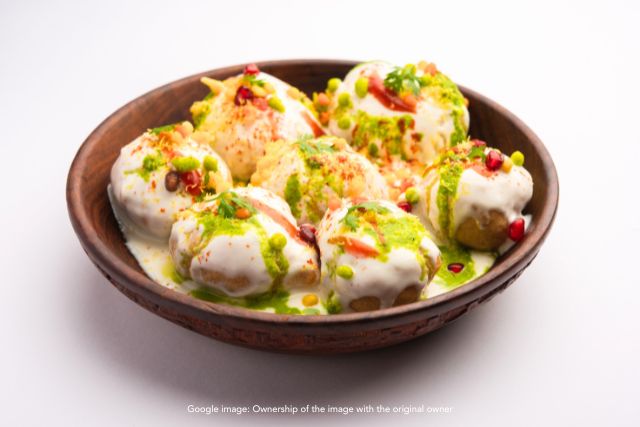
Black Gram Dahi Bara
Dahi Bara is a popular and beloved dish often enjoyed during festive occasions and special gatherings. Traditionally, it features deep-fried lentil cakes soaked in spiced yogurt, which adds a rich and indulgent flavor. However, this healthier variant of Dahi Bara provides a nutritious twist while maintaining the essence of the classic recipe. By opting for baked lentil cakes and using low-fat yogurt, you can enjoy a lighter, more health-conscious version of this dish. This recipe is perfect for those who want to indulge in festive foods without compromising their dietary goals. It’s an excellent choice for Chappan Bhog during Janmashtami, blending tradition with a touch of modern health awareness.
Ingredients: 1 cup black gram (urad dal), 1 cup low-fat yogurt, salt to taste, 1 tbsp olive oil
Preparation:
- Soak the Lentils: Rinse 1 cup of black gram (urad dal) thoroughly and soak in water for at least 4 hours or overnight.
- Drain and Blend: After soaking, drain the lentils and blend them into a smooth batter, adding a little water if necessary to achieve the desired consistency.
- Preheat the Oven: Preheat your oven to 375°F (190°C).
- Prepare the Baking Tray: Line a baking tray with parchment paper and lightly brush it with olive oil.
- Shape the Lentil Cakes: Spoon the lentil batter onto the prepared tray, shaping them into small, round cakes.
- Bake the Lentil Cakes: Place the tray in the oven and bake for about 20-25 minutes, or until the cakes are golden brown and crispy on the outside.
- Prepare the Yogurt Mixture: In a bowl, mix 1 cup of low-fat yogurt with a pinch of salt to taste.
- Assemble the Dish: Soak the baked lentil cakes in the yogurt mixture for a few minutes until they are well-coated and soft.
- Garnish: Optionally, you can garnish the Dahi Bara with chopped cilantro, cumin powder, or a sprinkle of chaat masala.
- Serve: Serve the healthier Dahi Bara chilled or at room temperature for the best flavor and texture.
Health Facts:
- Low in Fat: By using low-fat yogurt and baked lentil cakes, this recipe reduces overall fat content compared to the traditional deep-fried version.
- High in Protein: Urad dal is a great source of plant-based protein, essential for muscle repair and growth.
- Rich in Fiber: The lentil cakes provide dietary fiber, which aids in digestion and helps maintain a healthy digestive system.
- Low-Calorie Option: Baking instead of frying significantly lowers the calorie content, making it a suitable option for those watching their calorie intake.
- Beneficial for Heart Health: Olive oil, used in this recipe, is a heart-healthy fat that helps lower cholesterol levels and supports cardiovascular health.
- Improves Bone Health: Low-fat yogurt is rich in calcium, which is crucial for maintaining strong bones and teeth.
- Boosts Metabolism: The high protein and fiber content can help boost metabolism and promote a feeling of fullness.
- Supports Immune Function: Yogurt contains probiotics that contribute to a healthy gut microbiome, supporting overall immune function.
- Ideal for Festive Consumption: As part of Chappan Bhog during Janmashtami, this healthier variant allows for enjoyment of traditional flavors without excess calories or unhealthy fats.
- Helps Maintain Weight: The balanced combination of protein and fiber helps control appetite, making it easier to maintain a healthy weight.
Nutrient Breakdown per Serving:
Calories: 90 kcal
Carbohydrates: 10g
Protein: 5g
Fat: 3g
Fiber: 3g
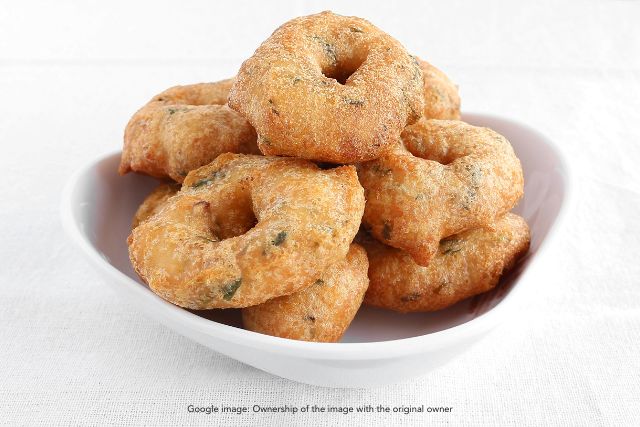
Black Gram Healthy Bara
Transform your Bara into a healthier treat with our revised recipe that combines traditional flavors with a nutritious twist. Instead of deep frying, we opt for baking, significantly reducing the fat content while retaining the classic taste. By using low-fat yogurt, we cut down on calories without compromising on flavor. This dish is perfect for celebrating Janmashtami with a healthier approach to your festive spread. Packed with protein from black gram and enhanced with the goodness of yogurt, this Bara is both satisfying and nutritious. Enjoy a festive treat that aligns with your health goals and still delivers on taste!
Ingredients:
- 1 cup black gram (urad dal),
- 1/4 cup low-fat yogurt,
- 2 tbsp olive oil,
- salt to taste
Preparation:
- Soak 1 cup of black gram (urad dal) overnight in water.
- Drain the soaked black gram and place it in a blender.
- Grind the black gram to a smooth paste, adding a little water if necessary.
- Transfer the paste to a mixing bowl.
- Add 1/4 cup of low-fat yogurt and salt to taste to the paste.
- Mix the ingredients thoroughly until well combined.
- Preheat your oven to 200°C (392°F).
- Shape the mixture into small patties or discs.
- Place the patties on a baking tray lined with parchment paper.
- Bake in the preheated oven for 15-20 minutes or until golden brown and crispy.
Health Facts:
- Black gram is a rich source of plant-based protein, essential for muscle repair and growth.
- Low-fat yogurt helps in reducing overall calorie content, making it a lighter option.
- Baking instead of frying decreases the fat content, promoting heart health.
- Black gram provides dietary fiber, aiding in digestion and promoting satiety.
- Low-fat yogurt offers probiotics that support gut health and enhance digestion.
- Baking helps retain more nutrients compared to frying, making it a healthier cooking method.
- Black gram is high in iron, which supports healthy blood circulation and energy levels.
- Low-fat yogurt contains calcium, crucial for maintaining strong bones and teeth.
- Baking minimizes the risk of consuming excess unhealthy fats that are present in deep-fried foods.
- Black gram has a low glycemic index, which helps in managing blood sugar levels and maintaining steady energy.
Nutrient Breakdown per Serving: Calories: 100 kcal
Carbohydrates: 12g
Protein: 5g
Fat: 3g
Fiber: 4g
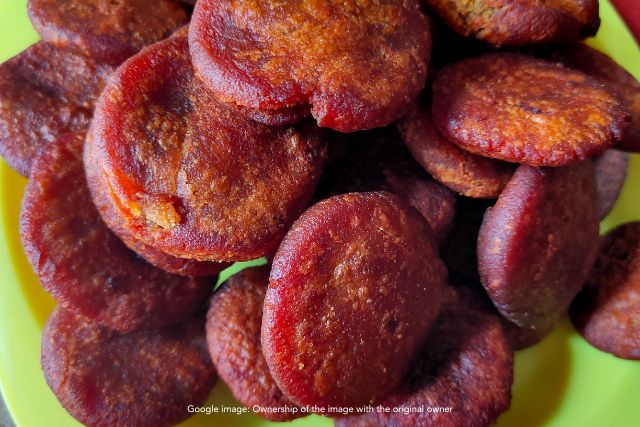
Brown Rice Arisa
Arisa is a traditional dish enjoyed during Janmashtami, and this healthier version offers a delightful twist on the classic recipe. By using brown rice flour instead of regular flour and opting for baking instead of frying, this variant reduces calories while boosting nutritional value. Coconut oil adds a rich flavor and healthy fats, while jaggery provides natural sweetness and essential minerals. This recipe aligns well with health-conscious eating habits without compromising on taste. It’s a great option for those looking to celebrate Janmashtami with a healthier approach. Enjoy the blend of tradition and wellness with this nutritious Arisa recipe.
Ingredients: 1 cup brown rice flour, 2 tbsp coconut oil, 1/4 cup jaggery
Preparation:
- Preheat your oven to 350°F (175°C).
- In a mixing bowl, combine 1 cup of brown rice flour with a pinch of salt.
- Melt 2 tablespoons of coconut oil and pour it into the bowl with the flour.
- Add 1/4 cup of jaggery, broken into small pieces, to the mixture.
- Mix all the ingredients thoroughly until a dough forms. If the dough is too dry, add a teaspoon of water at a time until it reaches the right consistency.
- Divide the dough into small balls and flatten each ball into a round disc shape.
- Place the discs on a baking sheet lined with parchment paper.
- Bake in the preheated oven for 15-20 minutes or until the edges turn golden brown.
- Remove from the oven and let them cool on a wire rack.
- Serve as a festive treat during Janmashtami or enjoy as a healthy snack.
Health Facts:
- Brown Rice Flour: Rich in fiber and essential nutrients, it aids in digestion and helps maintain steady blood sugar levels.
- Coconut Oil: Contains medium-chain triglycerides (MCTs) that can boost metabolism and support heart health.
- Jaggery: Provides iron, calcium, and magnesium, which are beneficial for overall health and can help prevent anemia.
- Lower in Calories: Baking instead of frying significantly reduces the calorie content, making it a healthier option.
- Nutrient-Rich: The use of brown rice flour adds vitamins B and E, promoting energy and skin health.
- Natural Sweetener: Jaggery is a natural alternative to refined sugar, reducing the risk of blood sugar spikes.
- Heart Health: Coconut oil may help increase good cholesterol (HDL) levels and support cardiovascular health.
- Digestive Health: The fiber in brown rice flour aids in digestion and can help prevent constipation.
- Immune Support: Jaggery contains antioxidants that can help strengthen the immune system.
- Holistic Benefits: This recipe aligns with traditional fasting practices during Janmashtami, offering a nutritious and festive option.
Nutrient Breakdown per Serving: Calories: 95 kcal
Carbohydrates: 18g
Protein: 2g
Fat: 3g
Fiber: 2g
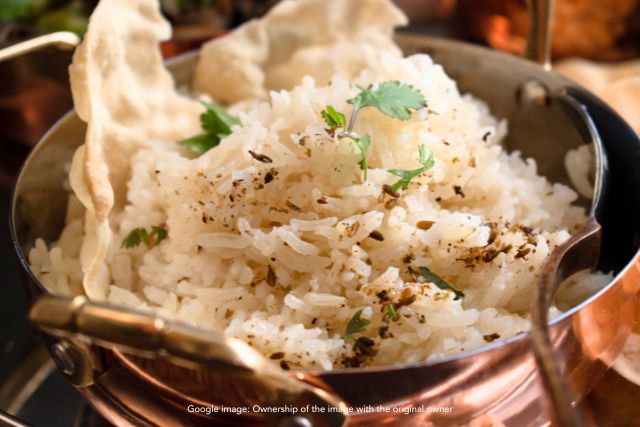
Brown Rice Ghea Anna
Indulge in a healthier version of Ghea Anna, a traditional dish of rice mixed with ghee. This recipe offers a nutritious twist by using brown rice and a lighter, more wholesome ghee alternative, ensuring a delightful and health-conscious addition to your festive celebrations.
Ingredients: 1 cup brown rice, rinsed 2 cups water 1 tablespoon ghee (or coconut oil for a vegan option) A pinch of salt
Preparation: Cook the brown rice in water until tender. Once cooked, fluff the rice and stir in the ghee (or coconut oil) and a pinch of salt. Serve warm.
Health Facts:
- Brown rice is high in fiber and beneficial for digestion.
- Ghee contains healthy fats that support heart health.
- Low in sodium, supporting better blood pressure management.
Nutrient Breakdown (per 100 grams):
Calories: 110 kcal
Carbohydrates: 22g
Protein: 2.5g
Fat: 3g
Fiber: 2g
Sodium: 10mg
Potassium: 50mg
Calcium: 10mg
Iron: 0.5mg
Vitamin C: 0mg
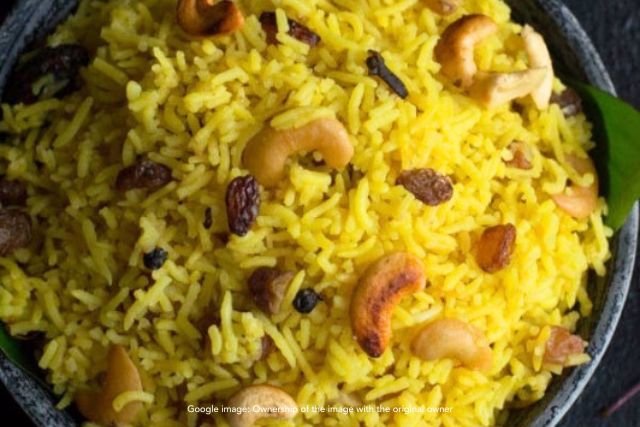
Brown Rice Kanika – Rice, Ghee, and Sugar
Transform the traditional Kanika into a healthier treat by using brown rice, reducing the amount of ghee, and substituting sugar with a natural sweetener like jaggery.
Ingredients:
- 1 cup brown rice, soaked for 30 minutes and drained
- 1 tablespoon ghee
- 1/4 cup jaggery, grated
- 2 cups water
- 1/2 teaspoon cardamom powder
- A pinch of saffron threads (optional)
Preparation: Heat the ghee in a large pot over medium heat. Add the soaked brown rice and sauté for a few minutes. Add water and bring to a boil. Reduce heat and simmer for 40 minutes, or until the rice is cooked. Stir in the grated jaggery, cardamom powder, and saffron threads until the jaggery melts and blends well with the rice. Serve warm.
Health Facts About Jaggery:
- Provides energy without the sugar crash.
- Contains iron and other minerals.
- Helps in detoxifying the liver.
Approximate Nutrient Breakdown Per 100 Grams:
- Calories: 130 kcal
- Carbohydrates: 27g
- Protein: 2g
- Fat: 1g
- Fiber: 1.5g
- Sodium: 3mg
- Potassium: 45mg
- Calcium: 12mg
- Iron: 1mg
- Vitamin C: 0mg
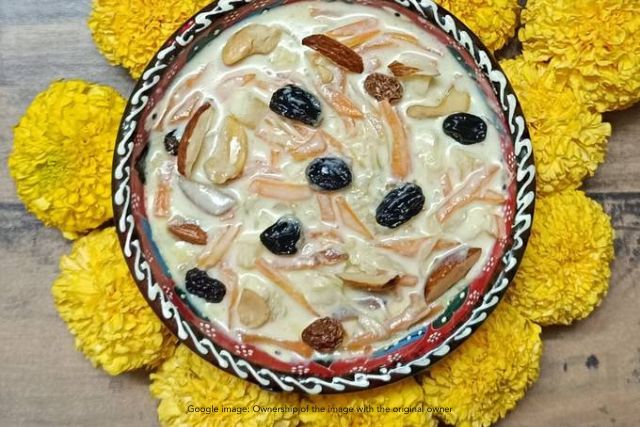
Brown Rice Kheer
Transform your traditional Khiri into a healthier delight with our updated recipe that’s perfect for Janmashtami! By swapping out white sugar for natural jaggery and using low-fat milk, this version of Khiri maintains its rich flavor while being lighter and more nutritious. This comforting dish combines the goodness of brown rice with the sweetness of jaggery, making it a wholesome choice for festive occasions. Ideal for those looking to enjoy traditional flavors without compromising on health, this Khiri offers a balanced treat for your celebrations. It’s easy to make and provides a nourishing option that aligns with dietary goals. Enjoy a classic festival favorite with a modern, health-conscious twist!
Ingredients:
- 1 cup low-fat milk,
- 1/4 cup brown rice,
- 2 tbsp jaggery
Preparation:
- Rinse 1/4 cup of brown rice under cold water.
- In a saucepan, heat 1 cup of low-fat milk over medium heat.
- Add the rinsed brown rice to the saucepan.
- Cook the rice in the milk, stirring occasionally, until the rice is tender and the milk is mostly absorbed (about 20 minutes).
- Reduce the heat to low and stir in 2 tablespoons of jaggery.
- Continue to simmer the mixture, stirring frequently, until it thickens to a creamy consistency.
- Ensure the jaggery is completely dissolved and well combined.
- Taste and adjust the sweetness if needed by adding a little more jaggery.
- Remove from heat and let it cool slightly before serving.
- Garnish with a sprinkle of cardamom powder or nuts if desired, and serve warm.
Health Facts:
- Jaggery vs. White Sugar: Jaggery is a natural sweetener that retains essential minerals like iron and calcium, making it a healthier alternative to white sugar.
- Low-Fat Milk: Using low-fat milk reduces the overall fat content of the dish while still providing essential protein and calcium.
- Brown Rice: Brown rice is high in fiber, which aids in digestion and helps maintain steady blood sugar levels.
- Reduced Caloric Intake: By substituting jaggery and using low-fat milk, the calorie content is lowered compared to traditional Khiri.
- Iron Content: Jaggery contributes to improved iron levels, helping to prevent anemia and support overall energy levels.
- Mineral Boost: Jaggery provides minerals such as magnesium and potassium, which are beneficial for heart health and maintaining electrolyte balance.
- Digestive Health: Brown rice and jaggery both support digestive health due to their high fiber content and natural digestive enzymes.
- Blood Sugar Regulation: The fiber in brown rice and the natural sugars in jaggery help in moderating blood sugar levels, making it a better choice for those managing diabetes.
- Nutrient Density: Low-fat milk still provides essential nutrients like vitamin D and calcium without the added fat, contributing to bone health.
- Natural Sweeteners: Jaggery’s natural sweetness can reduce the need for additional sweeteners, promoting a more balanced and less processed diet.
Nutrient Breakdown per Serving: Calories: 120 kcal
Carbohydrates: 22g
Protein: 4g
Fat: 2g
Fiber: 2g
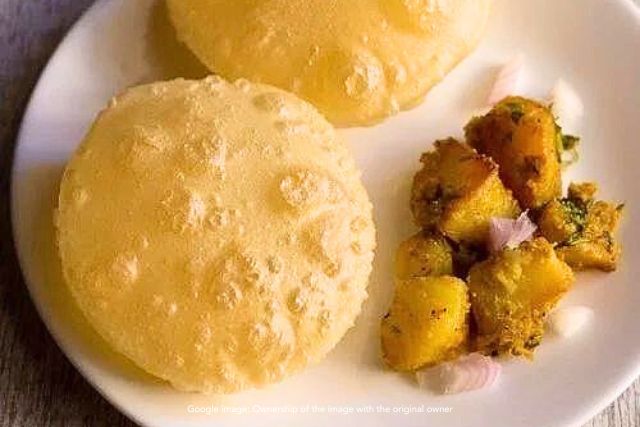
Brown Rice Luchi
Luchi, a popular Indian dish, is traditionally deep-fried and enjoyed for its soft and crispy texture. However, this healthy version provides a nutritious twist by incorporating brown rice flour and baking instead of frying. Brown rice flour is a great alternative to white flour, offering more fiber, vitamins, and minerals. By using olive oil and baking, this recipe significantly reduces unhealthy fats and calories. This healthier Luchi maintains the delicious taste while supporting a balanced diet. Ideal for special occasions like Janmashtami, it aligns with a health-conscious approach to festive eating.
Ingredients: 1 cup brown rice flour, 2 tbsp olive oil, a pinch of salt, water as needed
Preparation:
- Preheat your oven to 375°F (190°C).
- In a mixing bowl, combine 1 cup of brown rice flour with a pinch of salt.
- Add 2 tablespoons of olive oil to the flour mixture and stir until well blended.
- Gradually add water to the mixture, a little at a time, until a smooth dough forms.
- Knead the dough for a few minutes until it becomes soft and pliable.
- Divide the dough into small, equal-sized balls.
- On a lightly floured surface, roll out each ball into thin circles.
- Place the rolled dough onto a baking sheet lined with parchment paper.
- Bake in the preheated oven for 10-12 minutes or until the Luchi turns golden brown.
- Remove from the oven and let cool slightly before serving.
Health Facts:
- Brown rice flour contains more fiber than white rice flour, aiding in digestion and promoting gut health.
- Olive oil, used in this recipe, is rich in monounsaturated fats, which are beneficial for heart health.
- Baking instead of frying significantly reduces the calorie content and removes unhealthy trans fats.
- This recipe supports lower cholesterol levels due to the use of olive oil and whole-grain flour.
- Brown rice flour is a good source of magnesium, which supports bone health and helps regulate blood sugar levels.
- It provides essential vitamins such as B vitamins, which are important for energy metabolism.
- This healthier Luchi is gluten-free, making it suitable for individuals with gluten sensitivities or celiac disease.
- Using brown rice flour helps stabilize blood sugar levels compared to refined flour, beneficial for diabetes management.
- The recipe is lower in saturated fat, which is crucial for maintaining a healthy weight and reducing the risk of cardiovascular disease.
- Incorporating this version of Luchi during Janmashtami helps adhere to a healthier lifestyle while enjoying traditional festive foods.
Nutrient Breakdown per Serving: Calories: 85 kcal
Carbohydrates: 17g
Protein: 2g
Fat: 3g
Fiber: 2g
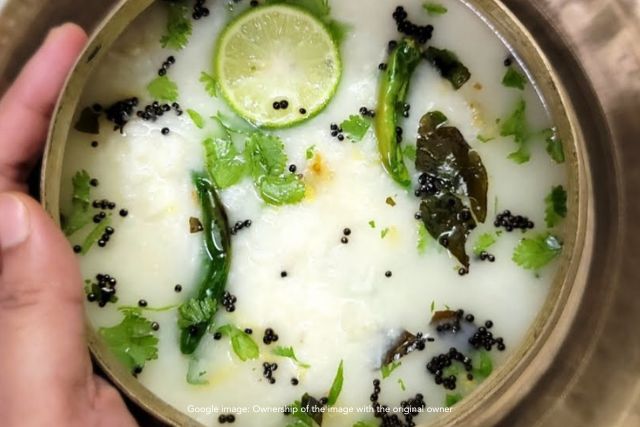
Brown Rice Oria Pakhal
Recreate Oria Pakhal with a healthier approach by using brown rice and a lighter touch of ghee, combined with refreshing lemon and a hint of Himalayan pink salt for a nutritious twist.
Ingredients: 1 cup brown rice, rinsed 2 cups water 1 tablespoon ghee (or coconut oil for a vegan option) Juice of 1 lemon A pinch of Himalayan pink salt
Preparation: Cook the brown rice in water until tender. Once cooked, mix in the ghee (or coconut oil), lemon juice, and Himalayan pink salt. Serve chilled or at room temperature.
Health Facts:
- Brown rice is high in fiber and essential nutrients.
- Lemon juice adds vitamin C and enhances flavor.
- Himalayan pink salt contains trace minerals beneficial for health.
Nutrient Breakdown (per 100 grams): Calories: 105 kcal
Carbohydrates: 22g
Protein: 2.5g
Fat: 2g
Fiber: 2g
Sodium: 50mg
Potassium: 40mg
Calcium: 10mg
Iron: 0.5mg
Vitamin C: 3mg
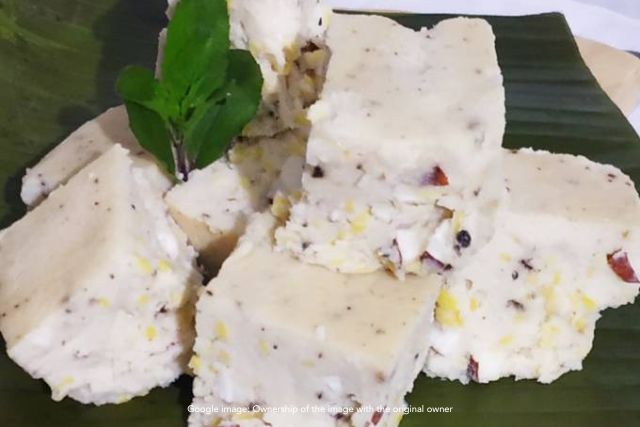
Ghee Mathapuli
Celebrate Janmashtami with a wholesome twist on the traditional Mathapuli. This healthier version preserves the essence of the classic dish while focusing on nutritious ingredients and minimal use of ghee. By incorporating mixed beans and fresh ginger, this recipe not only enhances flavor but also boosts the health benefits. Perfect for festive times, it offers a satisfying and guilt-free treat that aligns with your dietary goals. Enjoy a delicious snack that’s both nourishing and light on the palate. This Mathapuli is sure to be a hit at your celebration, combining tradition with a modern, health-conscious approach.
Ingredients:
- 1 cup mixed beans (soaked and ground into a thick paste)
- 1 tablespoon ghee
- 1 teaspoon ginger paste
- 1/2 teaspoon salt
Preparation:
- Soak mixed beans overnight and grind them into a thick paste.
- Heat a tablespoon of ghee in a pan over medium heat.
- Add a teaspoon of ginger paste to the ghee and sauté until fragrant.
- Incorporate the bean paste into the pan, mixing well with the ginger.
- Season the mixture with half a teaspoon of salt.
- Cook the bean mixture, stirring occasionally, until it thickens and begins to pull away from the pan.
- Remove the pan from heat and let the mixture cool slightly.
- Shape the thickened mixture into small patties.
- Preheat your oven to 180°C (350°F).
- Place the patties on a baking sheet and bake for 15-20 minutes or until golden brown.
Health Facts:
- Beans are a great source of plant-based protein, supporting muscle health and repair.
- Rich in dietary fiber, beans aid in digestive health and promote satiety.
- Ginger has anti-inflammatory properties and helps improve digestion.
- Minimal ghee reduces the fat content, making the recipe lighter and heart-healthy.
- Beans provide essential vitamins and minerals, including iron and potassium.
- The recipe is low in refined sugars and artificial additives, aligning with a clean-eating approach.
- Baking instead of frying reduces overall calorie and fat intake.
- Ginger contributes to better immune function and overall well-being.
- The use of natural ingredients ensures that the recipe remains free from processed components.
- This Mathapuli offers a balanced combination of protein and fiber, beneficial for blood sugar control and sustained energy levels.
Approximate Nutrient Breakdown (per 100 grams):
- Calories: 150 kcal
- Carbohydrates: 25g
- Protein: 7g Fat: 3g
- Fiber: 6g
- Sodium: 300mg
- Potassium: 250mg
- Calcium: 30mg
- Iron: 2.5mg
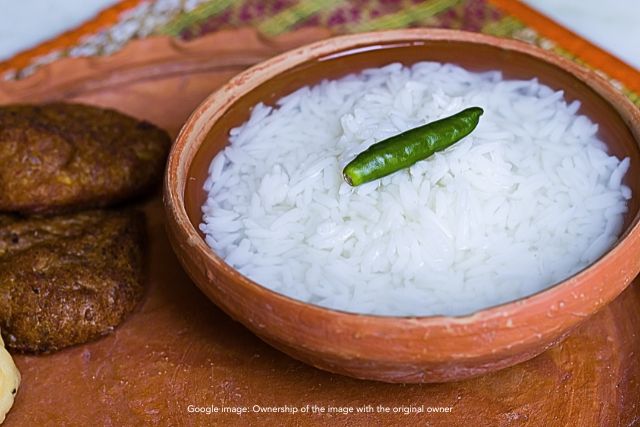
Healthy Ada Pakhal
Upgrade Ada Pakhal with brown rice and freshly grated ginger to create a more nutritious and flavorful dish.
Ingredients:
- 1 cup brown rice, soaked for 30 minutes and drained
- 4 cups water
- 1 tablespoon fresh ginger, grated
- A pinch of salt
Preparation: Boil water in a large pot. Add the soaked brown rice and grated ginger. Reduce the heat and simmer for 45 minutes, or until the rice is tender. Drain any excess water, fluff the rice with a fork, and serve warm.
Health Facts About Ginger:
- Contains anti-inflammatory properties.
- Aids in digestion.
- Boosts immunity with its antioxidant content.
Approximate Nutrient Breakdown Per 100 Grams:
- Calories: 105 kcal
- Carbohydrates: 22g
- Protein: 2g
- Fat: 0.4g
- Fiber: 1.8g
- Sodium: 3mg
- Potassium: 40mg
- Calcium: 10mg
- Iron: 0.5mg
- Vitamin C: 2mg
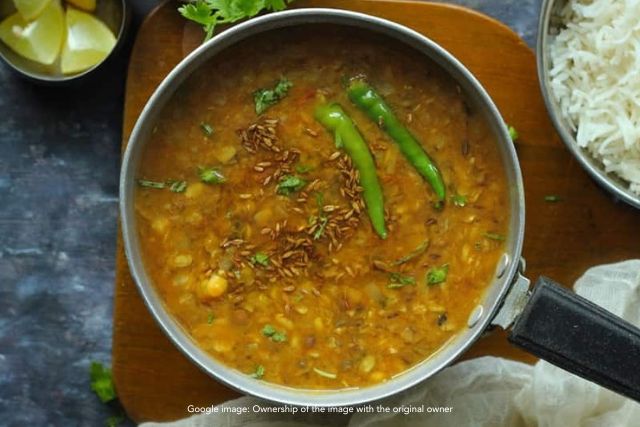
Healthy Baigilni
Transform your Baigilni into a health-conscious delight with this updated recipe that maintains its traditional charm while enhancing its nutritional value. This healthier version of Baigilni is perfect for Janmashtami, offering a satisfying and wholesome alternative to the classic dish. By incorporating nutrient-dense ingredients, you can enjoy the rich flavors of Baigilni without compromising your dietary goals. The recipe is designed to be both delicious and beneficial, ensuring that you can celebrate the festival with a dish that supports your health. Ideal for those mindful of their nutrition, this Baigilni variant keeps the festive spirit alive with every bite. Experience the joy of traditional flavors with a modern twist on health-conscious eating.
Ingredients:
1 cup cooked lentils
1/2 cup chopped tomatoes
1/4 cup chopped onions
1 tablespoon chopped garlic
1 teaspoon mustard seeds
1/2 teaspoon turmeric powder
1/2 teaspoon cumin powder
1/2 teaspoon coriander powder
1/2 teaspoon salt
1 tablespoon olive oil
1/4 cup chopped cilantro
Preparation:
- Heat olive oil in a pan over medium heat.
- Add mustard seeds and let them crackle.
- Sauté chopped garlic until it turns golden brown.
- Add chopped onions and cook until they become translucent.
- Stir in chopped tomatoes and cook until they are soft.
- Add turmeric powder, cumin powder, coriander powder, and salt to the mixture.
- Stir well and cook for another 2 minutes to blend the spices.
- Add the cooked lentils and mix thoroughly with the tomato-onion-spice mixture.
- Simmer for 5-7 minutes, allowing the flavors to meld together.
- Garnish with chopped cilantro before serving.
Health Facts About Baigilni:
- High Protein Content: Lentils are a great source of plant-based protein, essential for muscle repair and overall health.
- Rich in Fiber: Lentils provide dietary fiber, which aids in digestion and helps maintain healthy blood sugar levels.
- Low in Saturated Fat: Using olive oil instead of ghee reduces the amount of saturated fat in the recipe.
- Antioxidant Properties: Tomatoes and garlic are rich in antioxidants, which help combat free radicals and reduce inflammation.
- Supports Heart Health: The olive oil used in the recipe contains monounsaturated fats, which are beneficial for heart health.
- Vitamins and Minerals: This dish is packed with essential vitamins and minerals from ingredients like tomatoes and cilantro.
- Improves Digestion: The fiber in lentils and the prebiotics in garlic promote a healthy digestive system.
- Boosts Immunity: Garlic and turmeric have immune-boosting properties that can help keep illnesses at bay.
- Balances Blood Sugar: The combination of protein and fiber in lentils helps stabilize blood sugar levels, making it a good choice for diabetics.
- Hydration: The vegetables in the dish help maintain hydration levels, which is crucial for overall health.
Approximate Nutrient Breakdown of This Recipe for 100 Grams:
Calories: 120 kcal
Carbohydrates: 20g
Protein: 8g
Fat: 3g
Fiber: 6g
Sodium: 300mg
Potassium: 400mg
Calcium: 50mg
Iron: 3mg
Vitamin C: 15mg
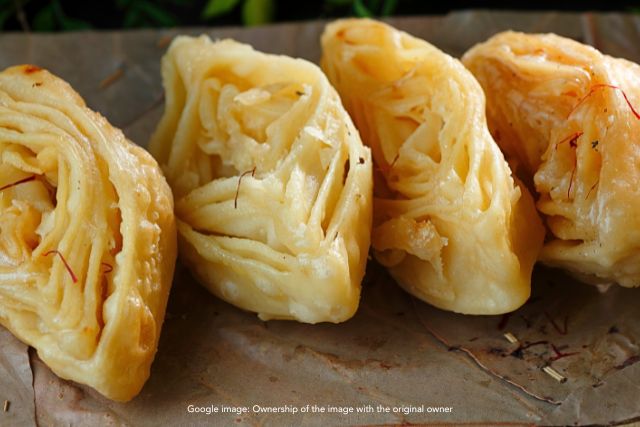
Healthy Bapudi Khaja
Discover a delightful twist on the traditional Bapudi Khaja with our healthier recipe. This beloved treat, often prepared with cream of milk, sugar, and ghee, is given a nutritious upgrade. By opting for low-fat cream and coconut sugar, this version maintains its delicious essence while being kinder to your waistline. Perfect for celebrating Janmashtami or enjoying a guilt-free dessert anytime. This recipe allows you to indulge without compromising on your health goals. Treat yourself to a nourishing version of this classic dish.
OUR HEALTHY BAPUDI KHAJA RECIPE
Ingredients:
- 1 cup low-fat cream
- 1/4 cup coconut sugar
- 1 tbsp ghee (clarified butter)
Preparation:
- Gather Ingredients: Ensure you have 1 cup of low-fat cream, 1/4 cup of coconut sugar, and 1 tablespoon of ghee.
- Heat Ghee: In a non-stick pan, melt the ghee over medium heat.
- Add Cream: Pour the low-fat cream into the pan and stir continuously to avoid curdling.
- Sweeten: Gradually add the coconut sugar, stirring until it fully dissolves into the cream.
- Simmer: Allow the mixture to simmer gently, stirring frequently to prevent sticking or burning.
- Thicken: Continue cooking until the mixture thickens to a creamy consistency.
- Cool Slightly: Remove the pan from heat and let the mixture cool slightly.
- Shape: Pour the mixture into a shallow dish or mold and spread it evenly.
- Chill: Refrigerate for at least 2 hours or until set.
- Serve: Cut into squares or desired shapes and enjoy your healthy Bapudi Khaja.
HEALTH FACTS ABOUT CREAM:
- Low-Fat Cream: Using low-fat cream reduces the overall fat content compared to traditional cream, making it a lighter option.
- Coconut Sugar: Coconut sugar has a lower glycemic index than regular sugar, which helps in maintaining stable blood sugar levels.
- Ghee Benefits: Ghee, while still a fat, is rich in healthy fats and can aid in better digestion and absorption of nutrients.
- Reduced Calories: By substituting full-fat cream and regular sugar with their healthier counterparts, this version is lower in calories.
- Digestive Health: Ghee supports a healthy digestive system and can be easier to digest than other forms of butter.
- Nutrient-Rich: Coconut sugar contains trace amounts of vitamins and minerals like iron, zinc, and calcium.
- Anti-Inflammatory: Ghee has anti-inflammatory properties, which can be beneficial for overall health.
- Traditional Benefits: Even in its healthier form, Bapudi Khaja retains the traditional benefits of ghee and coconut sugar, aligning with the spirit of Janmashtami.
- Energy Boost: Coconut sugar provides a steady release of energy, unlike refined sugars that cause spikes and crashes.
- Celebration-Friendly: This healthier recipe allows you to enjoy a festive treat during Janmashtami without compromising your dietary goals.
APPROXIMATE NUTRIENT BREAKDOWN PER 100 GRAMS:
- Calories: 160 kcal
- Carbohydrates: 15g
- Protein: 3g
- Fat: 10g
- Fiber: 0g
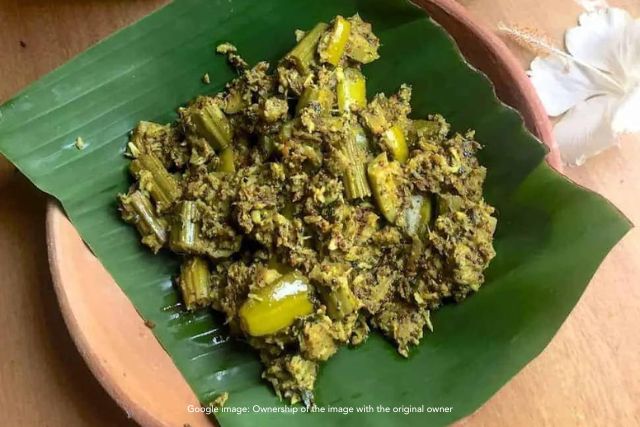
Healthy Bottle Gourd Besar
Indulge in the traditional flavors with a healthy spin on Besar through our Healthy Besar recipe – a flavorful and nourishing dish featuring a blend of spices and fresh vegetables. This version ensures you enjoy all the goodness of Besar with reduced fat and increased nutrient density, making it a delicious and wholesome choice for your meals.
Ingredients: 1 cup chopped bottle gourd 1/2 cup chopped carrots 1/2 cup diced potatoes 1 tablespoon ginger-garlic paste 1/2 teaspoon turmeric powder 1/2 teaspoon cumin seeds 1/2 teaspoon fennel seeds 1/2 teaspoon mustard seeds Salt to taste 2 cups water
Preparation:
- Heat a pan and add cumin seeds, fennel seeds, and mustard seeds. Sauté until fragrant.
- Add ginger-garlic paste and cook for a minute.
- Add the chopped vegetables, turmeric powder, and salt. Stir well.
- Pour in water and simmer until vegetables are cooked through.
Health Facts About Besar:
- Provides a good mix of vitamins and minerals, including vitamin C and potassium.
- Low in fat and calories, making it suitable for weight management.
- Contains antioxidants from spices, which have anti-inflammatory benefits.
Approximate Nutrient Breakdown for 100 Grams of This Recipe: Calories: 100 kcal
Carbohydrates: 20g
Protein: 3g
Fat: 1g
Fiber: 4g
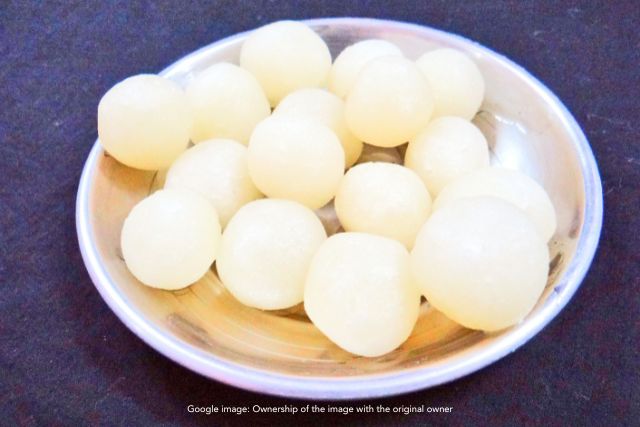
Healthy Chhena Khai
Celebrate Janmashtami with a healthier twist on Chhena Khai, a traditional treat that’s both delicious and nutritious. Typically made with fresh cheese, milk, and sugar, this updated version uses low-fat milk and honey to provide a lighter, yet satisfying dessert.
By incorporating low-fat paneer and natural honey, we enhance the dish’s nutritional profile while maintaining its rich, creamy texture. This modern take on Chhena Khai not only aligns with health-conscious choices but also keeps the festive spirit alive. Enjoy a sweet treat that’s lower in fat and calories, making it a guilt-free option for your celebrations.
Perfect as a post-meal dessert or a special treat, this recipe ensures you can indulge without compromising your health goals. This healthier version of Chhena Khai remains true to its roots while offering a fresh, nutritious approach. It’s a delightful way to enjoy traditional flavors with a contemporary, healthful twist.
Experience the best of both worlds with this easy-to-make, nutritious dessert that’s sure to be a hit at your Janmashtami festivities.
OUR HEALTHY CHHENA KHAI RECIPE
Ingredients:
- 1 cup low-fat milk
- 1/2 cup low-fat paneer (fresh cheese)
- 1/4 cup honey
Preparation:
- Start by boiling 1 cup of low-fat milk in a saucepan over medium heat.
- Continue to boil the milk until it reduces by half, stirring occasionally.
- Crumble 1/2 cup of low-fat paneer and set aside.
- Once the milk has reduced, add the crumbled paneer to the saucepan.
- Stir the mixture well to combine the paneer with the reduced milk.
- Add 1/4 cup of honey to the mixture.
- Continue to cook the mixture over low heat until it thickens to a creamy consistency.
- Stir occasionally to prevent sticking or burning.
- Once thickened, remove from heat and let it cool slightly.
- Serve the Chhena Khai warm or chilled, as per your preference.
HEALTH FACTS ABOUT THE DISH:
- Low-fat milk reduces overall fat content, making it a heart-healthier choice.
- Paneer provides a good source of protein, aiding in muscle repair and growth.
- Honey offers natural sweetness with fewer empty calories compared to refined sugars.
- Honey is rich in antioxidants, which help combat oxidative stress and inflammation.
- Using low-fat paneer lowers cholesterol levels, contributing to heart health.
- Low-fat milk is lower in calories, making it suitable for weight management.
- Honey contains B vitamins that are essential for energy metabolism.
- The combination of honey and paneer provides a balanced source of protein and healthy carbohydrates.
- Low-fat milk supports bone health with its calcium content while minimizing saturated fat intake.
- This recipe avoids processed sugars and unhealthy fats, aligning with a more nutritious diet.
APPROXIMATE NUTRIENT BREAKDOWN PER 100 GRAMS:
- Calories: 120 kcal
- Carbohydrates: 20g
- Protein: 6g
- Fat: 3g
- Fiber: 0g
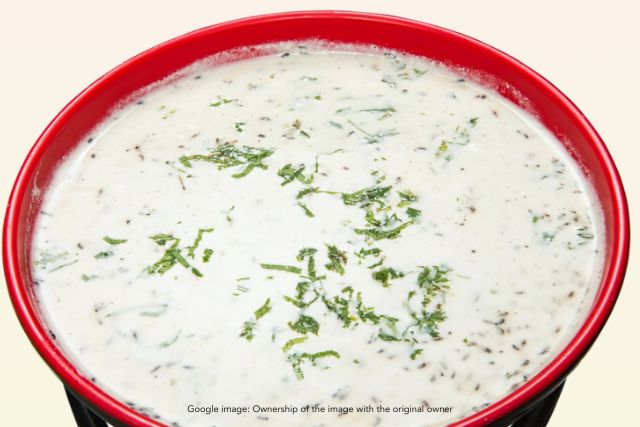
Healthy Dahi Pakhal
Our healthier version of Dahi Pakhal uses low-fat yogurt and brown rice, making it a lighter yet nutritious option that’s perfect for a refreshing meal.
Ingredients:
- 1 cup brown rice, soaked for 30 minutes and drained
- 1 cup low-fat yogurt
- 2 cups water
- A pinch of salt
- 1 tablespoon chopped cilantro
Preparation: Cook the brown rice in water until tender, then let it cool. Mix the cooled rice with low-fat yogurt and salt. Garnish with chopped cilantro and serve chilled.
Health Facts About Low-Fat Yogurt:
- High in protein for muscle health.
- Contains probiotics that promote gut health.
- Low in fat, making it heart-friendly.
Approximate Nutrient Breakdown Per 100 Grams:
- Calories: 80 kcal
- Carbohydrates: 15g
- Protein: 3g
- Fat: 1g
- Fiber: 1g
- Sodium: 50mg
- Potassium: 80mg
- Calcium: 100mg
- Iron: 0.3mg
- Vitamin C: 1mg
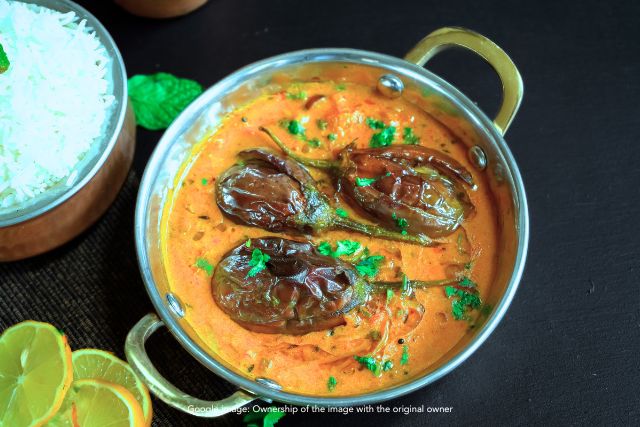
Healthy Goti Baigana
Relish the flavors with our Healthy Goti Baigana recipe – a delightful dish that incorporates eggplants in a heart-healthy, low-fat preparation. This updated version maintains the traditional taste while offering a more nutritious profile that's perfect for health-conscious eaters. Rich in essential nutrients and prepared with minimal oil, this Goti Baigana is ideal for those celebrating Janmashtami while prioritizing their well-being. Enjoy a traditional favorite with a modern twist that supports your health goals without compromising on flavor. Our recipe brings together wholesome ingredients to create a satisfying dish that fits seamlessly into any balanced diet. Perfect for festive gatherings, this dish is a delicious and nutritious choice.
Ingredients:
- 2 cups chopped eggplant
- 1/2 cup chopped tomatoes
- 1 tablespoon ginger-garlic paste
- 1/2 teaspoon turmeric powder
- 1/2 teaspoon cumin seeds
- 1/2 teaspoon coriander powder
- 1/2 teaspoon chili powder
- Salt to taste
- 1 cup water
Preparation:
- Heat a non-stick skillet over medium heat.
- Add cumin seeds and sauté for a minute until they become aromatic.
- Add the ginger-garlic paste and cook for another 2 minutes.
- Stir in the chopped tomatoes and cook until they are soft and pulpy.
- Add turmeric powder, coriander powder, and chili powder, and mix well.
- Add the chopped eggplant and stir to coat with the spices.
- Pour in the water and bring the mixture to a simmer.
- Cover and cook for 15-20 minutes until the eggplants are tender.
- Stir occasionally to ensure the mixture doesn't stick to the pan.
- Season with salt to taste and garnish with fresh herbs if desired.
Health Facts About Goti Baigana:
- Low in Calories: Eggplants are naturally low in calories, making this dish ideal for weight management.
- Rich in Fiber: Provides dietary fiber that supports digestive health and promotes satiety.
- Antioxidant-Rich: Eggplants contain antioxidants like nasunin, which help fight oxidative stress.
- Supports Heart Health: Low in fat and high in potassium, which is beneficial for maintaining healthy blood pressure levels.
- Anti-Inflammatory Properties: Turmeric has anti-inflammatory benefits that may help reduce inflammation in the body.
- Rich in Vitamins: Tomatoes provide vitamins C and A, which support immune function and skin health.
- Low in Fat: Prepared with minimal oil, making it a heart-healthy choice.
- Good for Metabolism: Ginger-garlic paste boosts metabolism and has immune-boosting properties.
- Hydrating: Contains a high water content that aids in hydration and helps keep the body balanced.
- Maintains Blood Sugar Levels: The fiber content helps in stabilizing blood sugar levels, which is beneficial for those managing diabetes.
Approximate Nutrient Breakdown for 100 Grams of This Recipe: Calories: 80 kcal
Carbohydrates: 10g
Protein: 2g
Fat: 4g
Fiber: 3g
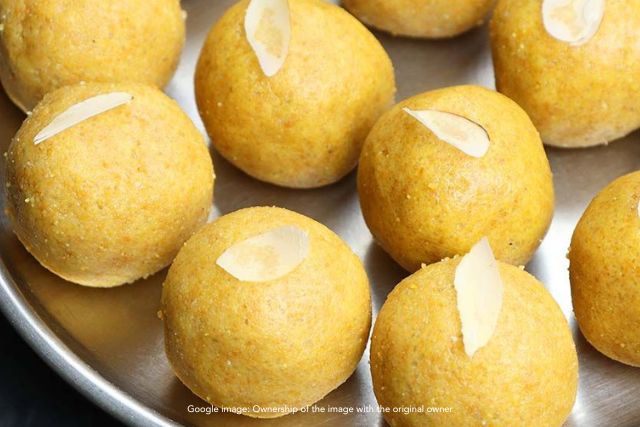
Healthy Magaja Ladu
Get ready to enjoy a healthier twist on Magaja Ladu – a delightful snack made with wholesome ingredients that offer a nutritious boost without compromising on taste. This recipe uses minimal ghee and replaces refined sugar with natural sweeteners, ensuring you get a delicious and healthful treat perfect for festive occasions.
Ingredients:
- 1 cup whole wheat flour,
- roasted 1/2 cup jaggery powder
- 2 tablespoons ghee
- 1/4 cup chopped nuts (almonds, cashews)
- 1/2 teaspoon cardamom powder
- 2 tablespoons grated coconut
Preparation: Dry roast the whole wheat flour in a pan until it turns golden brown. Add ghee and mix well. Stir in jaggery powder, chopped nuts, cardamom powder, and grated coconut. Mix until everything is well combined. Shape the mixture into small laddus and let them cool.
Health Facts:
- Rich in fiber from whole wheat flour.
- Contains healthy fats from nuts and ghee.
- Uses jaggery as a natural sweetener, which is rich in minerals.
- Provides a good source of energy.
Approximate Nutrient Breakdown (per 100 grams):
- Calories: 250 kcal
- Carbohydrates: 35g
- Protein: 4g
- Fat: 10g Fiber: 4g
- Sodium: 10mg
- Potassium: 100mg
- Calcium: 30mg
- Iron: 2mg
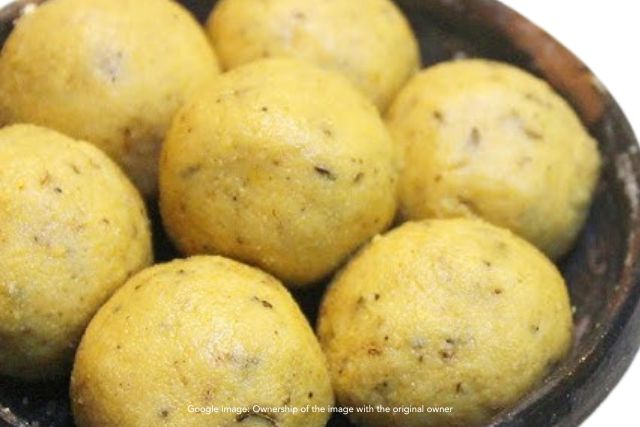
Healthy Marichi Laduoo
Enjoy a healthier version of Marichi Ladu, a beloved traditional treat that’s been reimagined with nutritious ingredients for a guilt-free indulgence! This recipe substitutes refined flour and sugars with wholesome alternatives like whole wheat flour and jaggery, making it a lighter and healthier option. Infused with the rich flavor of ghee, these laddus offer a satisfying taste without compromising on health benefits. Perfect for celebrating Janmashtami, this variation maintains the essence of tradition while enhancing your nutritional intake. Savor this delectable treat and enjoy the festive spirit with a touch of wellness. This recipe not only honors tradition but also supports your health goals with every bite!
Ingredients:
- 1 cup whole wheat flour
- 1/2 cup jaggery powder
- 2 tablespoons ghee
Preparation:
- Heat a pan over medium heat.
- Add the whole wheat flour to the pan.
- Roast the flour, stirring continuously, until it turns golden brown and emits a nutty aroma.
- Remove the roasted flour from the pan and set aside to cool slightly.
- In the same pan, add ghee and heat it until melted.
- Reduce the heat and add the roasted flour back into the pan.
- Mix well to ensure the ghee is evenly incorporated into the flour.
- Gradually stir in the jaggery powder until it melts and combines thoroughly with the flour.
- Continue to cook the mixture for a few more minutes, stirring constantly.
- Remove from heat, let it cool slightly, and shape into small laddus. Allow them to cool completely before serving.
Health Facts:
- Whole Wheat Flour is high in dietary fiber, which aids in digestion and helps maintain healthy blood sugar levels.
- Jaggery is a natural sweetener that contains essential minerals such as iron, calcium, and magnesium, contributing to overall wellness.
- Ghee provides healthy fats that support brain function and cardiovascular health.
- Whole Wheat Flour is rich in B-vitamins, which play a key role in energy metabolism and nervous system health.
- Jaggery can help boost immunity due to its antioxidant properties, which help fight oxidative stress.
- Ghee is known for its anti-inflammatory properties, which can help reduce inflammation in the body.
- Whole Wheat Flour helps in maintaining a healthy weight by promoting a feeling of fullness and reducing overeating.
- Jaggery aids in detoxifying the liver by promoting the production of digestive enzymes.
- Ghee is beneficial for skin health, as it helps in keeping the skin moisturized and glowing.
- Jaggery can improve hemoglobin levels and prevent anemia, making it a beneficial addition to your diet, especially for those with iron deficiencies.
Approximate Nutrient Breakdown (per 100 grams):
- Calories: 240 kcal
- Carbohydrates: 40g
- Protein: 3g Fat: 9g Fiber: 4g
- Sodium: 5mg
- Potassium: 90mg
- Calcium: 20mg
- Iron 2mg
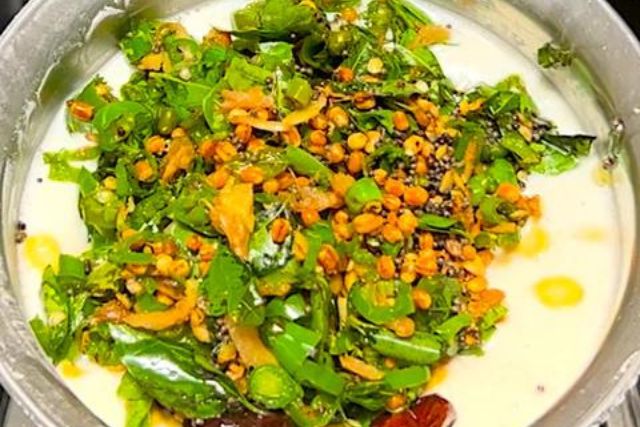
Healthy Maur Recipe
Enjoy a refreshing and nutrient-packed version of Maur with our Healthy Maur recipe – a vibrant, protein-rich dish that's perfect for any occasion. By using fresh, wholesome ingredients, this healthy variant preserves the traditional flavors while offering a light, nutrient-dense meal that’s full of flavor and goodness.
Ingredients: 1 cup chopped raw papaya 1/2 cup cooked chickpeas 1/2 cup diced carrots 1/2 cup chopped beans 1 tablespoon ginger paste 1/2 teaspoon turmeric powder 1/2 teaspoon cumin seeds 1/2 teaspoon coriander powder 1/2 teaspoon garam masala Salt to taste 2 cups water
Preparation:
- Heat a pan and add cumin seeds. Once they splutter, add ginger paste and sauté briefly.
- Add chopped papaya, carrots, and beans. Stir and cook for a few minutes.
- Add turmeric powder, coriander powder, and salt. Mix well.
- Pour in the water and cook until vegetables are tender.
- Stir in the cooked chickpeas and garam masala. Simmer for another 5 minutes.
Health Facts About Maur:
- High in dietary fiber and protein for digestive and muscle health.
- Rich in vitamins A and C from the vegetables for immune support.
- Low in fat and provides essential minerals like potassium and magnesium.
Approximate Nutrient Breakdown for 100 Grams of This Recipe: Calories: 110 kcal
Carbohydrates: 18g
Protein: 5g
Fat: 1g
Fiber: 4g
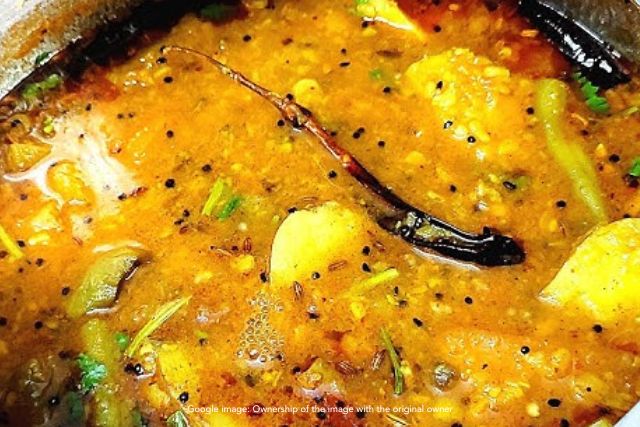
Healthy Mix Moong Dal Dalama
Get ready to enjoy a nutritious twist on the traditional Dalama with our Healthy Dalama recipe – a wholesome dish combining dals and vegetables in a balanced and flavor-packed way! This updated version emphasizes fresh, nutrient-dense ingredients and offers a heart-healthy, protein-rich meal that's perfect for any festive occasion. Packed with vitamins, minerals, and fiber, this recipe ensures you get all the essential nutrients without compromising on taste.
Ingredients: 1 cup mixed dal (moong dal, toor dal, and masoor dal) 1 cup chopped eggplant 1 cup chopped beans 1 cup chopped sweet potato 1/2 cup grated coconut 1 dried Bodhi root (or substitute with extra mushrooms for a similar texture) 1/2 teaspoon turmeric powder 1/2 teaspoon cumin seeds 1/2 teaspoon mustard seeds 1/2 teaspoon fenugreek seeds Salt to taste 2 cups water
Preparation:
- Rinse the mixed dals thoroughly and cook them in a pressure cooker with 2 cups of water until soft.
- In a separate pan, heat a teaspoon of oil and add cumin seeds, mustard seeds, and fenugreek seeds. Sauté until fragrant.
- Add the chopped vegetables and Bodhi root (or mushrooms) to the pan. Stir and cook for a few minutes.
- Add turmeric powder and salt, then mix well.
- Combine the cooked dals with the vegetable mixture. Simmer for 10-15 minutes until the vegetables are tender and flavors meld together.
- Stir in grated coconut and cook for another 5 minutes.
Health Facts About Dalama:
- Rich in plant-based protein and fiber for satiety and muscle health.
- Provides essential vitamins and minerals, including iron and calcium.
- Low in fat and cholesterol, supporting heart health.
- High in antioxidants and anti-inflammatory compounds.
Approximate Nutrient Breakdown for 100 Grams of This Recipe: Calories: 120 kcal
Carbohydrates: 20g
Protein: 6g
Fat: 2g
Fiber: 5g
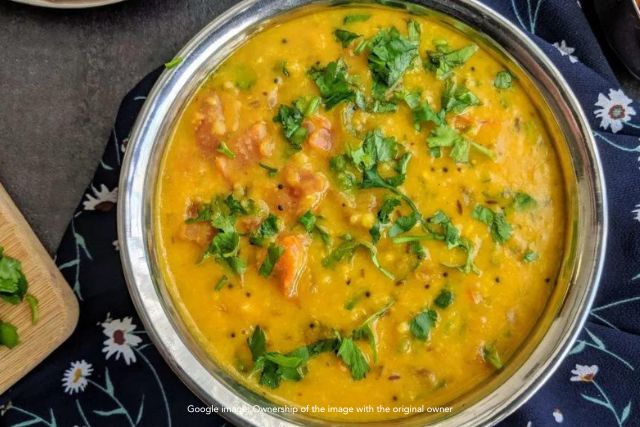
Healthy Muga Dal
Experience a nourishing twist on a traditional favorite with our Healthy Muga Dal recipe. This protein-packed dish highlights the wholesome goodness of split green gram while staying true to the classic flavors you love. By reducing oil and incorporating powerful spices, this version ensures you get all the benefits of a healthful diet. Ideal for any meal, it’s particularly fitting for Chappan Bhog during Janmashtami, where a balanced, nutritious diet is celebrated. Enjoy the rich taste and vibrant nutrition of this updated recipe. Dive into a bowl of Muga Dal that’s both satisfying and beneficial for your health.
Ingredients: 1 cup split green gram (muga dal) 1 onion, finely chopped 1 tomato, chopped 1/2 teaspoon turmeric powder 1/2 teaspoon cumin seeds 1/2 teaspoon mustard seeds 1/2 teaspoon coriander powder 1/2 teaspoon chili powder Salt to taste 2 cups water
Preparation:
- Rinse the Muga Dal: Wash 1 cup of split green gram under cold water until the water runs clear. This helps remove any impurities and excess starch.
- Soak the Dal: Soak the rinsed dal in water for 30 minutes to soften it and reduce cooking time.
- Heat the Pan: In a large, non-stick pan, heat a small amount of water or use a non-stick spray to avoid using oil.
- Add Spices: Add 1/2 teaspoon of cumin seeds and 1/2 teaspoon of mustard seeds to the pan, allowing them to sizzle for a few seconds.
- Sauté Onion: Add 1 finely chopped onion and cook until it becomes translucent.
- Incorporate Tomato: Stir in 1 chopped tomato and cook until it softens and blends with the onion.
- Add Spices: Mix in 1/2 teaspoon of turmeric powder, 1/2 teaspoon of coriander powder, and 1/2 teaspoon of chili powder. Stir well.
- Add Dal: Drain the soaked dal and add it to the pan, stirring to combine with the spice mixture.
- Add Water: Pour in 2 cups of water and bring the mixture to a boil.
- Simmer: Reduce the heat to low and let it simmer for 20-25 minutes or until the dal is tender. Add salt to taste before serving.
Health Facts About Muga Dal:
- Protein-Rich: Muga Dal is an excellent source of protein, which is essential for muscle repair and overall growth.
- High in Fiber: This recipe provides a good amount of dietary fiber, aiding in digestion and helping maintain a healthy weight.
- Low in Fat: By minimizing oil use, this version of Muga Dal is low in fat, supporting heart health.
- Rich in Vitamins: Muga Dal contains essential vitamins such as B vitamins, which are important for energy metabolism and cognitive function.
- Mineral-Dense: It is packed with minerals like iron, magnesium, and potassium, which are crucial for various bodily functions.
- Anti-Inflammatory Spices: The turmeric and coriander powder used in the recipe have anti-inflammatory properties, helping to reduce inflammation in the body.
- Supports Immunity: The spices and dal contribute to a stronger immune system, helping your body fight off infections.
- Regulates Blood Sugar: Muga Dal has a low glycemic index, which can help in managing blood sugar levels, making it suitable for diabetic individuals.
- Boosts Energy: The high protein and fiber content helps sustain energy levels throughout the day.
- Cultural Significance: During Janmashtami, Chappan Bhog offerings like Muga Dal are considered auspicious and are believed to bring health and prosperity.
Approximate Nutrient Breakdown for 100 Grams of This Recipe: Calories: 130 kcal
Carbohydrates: 22g
Protein: 8g
Fat: 1g
Fiber: 5g
Sodium: 180mg
Potassium: 300mg
Calcium: 50mg
Iron: 2mg
Vitamin C: 6mg
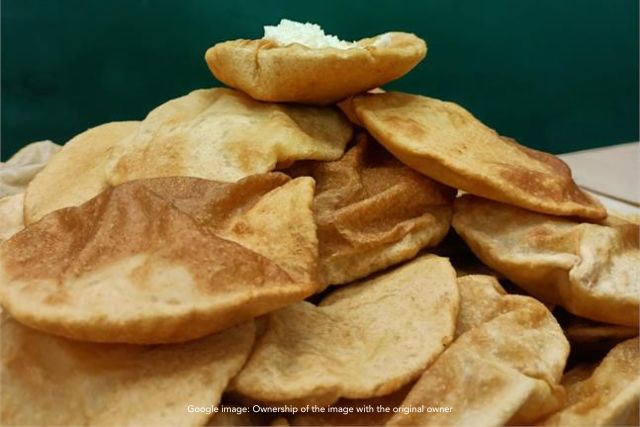
Healthy Pita
Elevate your Janmashtami celebrations with a nutritious twist on the classic Pita, blending healthful ingredients with festive cheer. This revamped recipe replaces traditional elements with wholesome alternatives, ensuring you enjoy a delightful treat while sticking to your wellness goals. Our healthier Pita is designed to be both satisfying and nourishing, making it a perfect choice for those mindful of their diet during the festive season. Infused with fresh spinach and aromatic spices, this Pita offers a refreshing taste that's both flavorful and beneficial. Whether you're observing Janmashtami or simply seeking a wholesome snack, this recipe brings joy to both your palate and your health. Treat yourself to a festive dish that harmonizes taste and nutrition effortlessly.
Ingredients:
1 cup whole wheat flour
1/2 cup finely chopped spinach
1/4 cup finely chopped onions
1/4 cup grated low-fat cheese (optional)
1/4 teaspoon turmeric powder
1/4 teaspoon black pepper
1/4 teaspoon salt
1 tablespoon olive oil
Preparation:
- Preheat Oven: Preheat your oven to 375°F (190°C).
- Prepare Ingredients: In a large mixing bowl, combine 1 cup of whole wheat flour, 1/2 cup of finely chopped spinach, and 1/4 cup of finely chopped onions.
- Add Spices: Mix in 1/4 teaspoon of turmeric powder, 1/4 teaspoon of black pepper, and 1/4 teaspoon of salt to the flour mixture.
- Incorporate Cheese: If using, add 1/4 cup of grated low-fat cheese to the bowl.
- Add Oil: Stir in 1 tablespoon of olive oil to the mixture.
- Mix and Knead: Gradually add water as needed and knead the dough until smooth and pliable.
- Roll Dough: Divide the dough into small balls and roll each ball into a thin circle on a floured surface.
- Bake Pitas: Place the rolled dough on a baking sheet and bake in the preheated oven for 8-10 minutes or until lightly golden.
- Cool: Allow the baked Pitas to cool on a wire rack.
- Serve: Enjoy the Pitas warm or at room temperature, perfect for a festive occasion or as a wholesome snack.
Health Facts About Pita:
Whole Wheat Flour: Using whole wheat flour adds fiber to the recipe, which aids in digestion and helps maintain steady blood sugar levels.- Spinach: Spinach is rich in vitamins A and C, iron, and antioxidants, supporting overall health and boosting immunity.
- Low-Fat Cheese: If included, low-fat cheese provides calcium and protein without excessive saturated fat.
- Olive Oil: Olive oil offers healthy monounsaturated fats, which are beneficial for heart health.
- Turmeric Powder: Turmeric contains curcumin, which has anti-inflammatory and antioxidant properties.
- Black Pepper: Black pepper aids in digestion and enhances the bioavailability of nutrients.
- Reduced Sodium: Using a controlled amount of salt helps manage sodium intake, promoting better cardiovascular health.
- Low Calorie: This recipe is lower in calories compared to traditional Pita, making it a better option for weight management.
- Nutrient-Dense: The combination of vegetables and whole grains makes the Pita nutrient-dense, providing essential vitamins and minerals.
- Festive and Healthy: This recipe aligns with the principles of a balanced diet while fitting the festive spirit of Janmashtami, allowing you to enjoy a traditional treat in a healthier form.
Approximate Nutrient Breakdown of This Recipe for 100 Grams:
Calories: 150 kcal
Carbohydrates: 30g
Protein: 5g
Fat: 2g
Fiber: 5g
Sodium: 250mg
Potassium: 300mg
Calcium: 80mg
Iron: 2mg
Vitamin C: 10mg
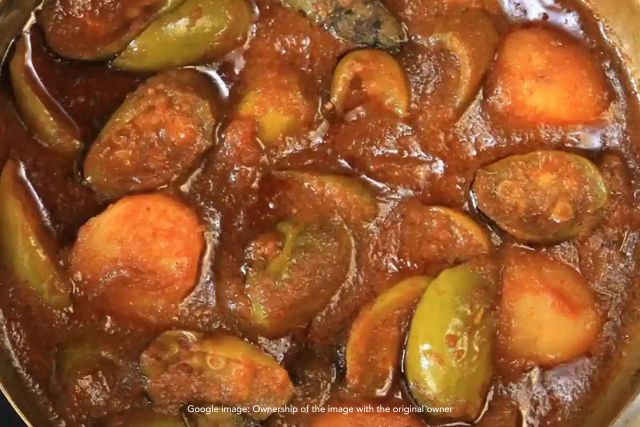
Healthy Potala Rasa
Transform your meal with our Healthy Potala Rasa recipe – a wholesome dish featuring a rich blend of spices and tender vegetables. This healthy variant ensures you enjoy the traditional flavors while benefiting from a nutrient-rich, low-fat meal that's perfect for any festive occasion.
Ingredients: 1 cup chopped potala (pointed gourd) 1/2 cup chopped potatoes 1/2 cup chopped tomatoes 1 tablespoon ginger paste 1/2 teaspoon turmeric powder 1/2 teaspoon cumin seeds 1/2 teaspoon coriander powder 1/2 teaspoon chili powder Salt to taste 1 cup water
Preparation:
- Heat a pan and add cumin seeds. Sauté briefly.
- Add ginger paste and cook for a minute.
- Add chopped tomatoes, turmeric powder, coriander powder, and salt. Cook until tomatoes are soft.
- Add the chopped potala and potatoes. Stir well.
- Pour in water and cook until vegetables are tender.
Health Facts About Potala Rasa:
- Provides dietary fiber and essential vitamins from vegetables.
- Low in fat and high in antioxidants from spices.
- Supports digestion and overall health.
Approximate Nutrient Breakdown for 100 Grams of This Recipe: Calories: 90 kcal
Carbohydrates: 15g
Protein: 3g
Fat: 2g
Fiber: 4g
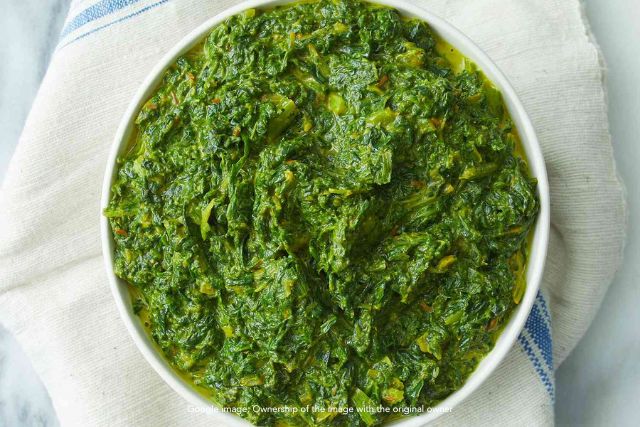
Healthy Saag
Savor the nutritious benefits of spinach with our Healthy Sag recipe – a dish that’s rich in iron and antioxidants, providing a hearty and healthy addition to your meal. This updated version maintains the traditional essence while offering enhanced nutritional value and reduced calorie content.
Ingredients: 2 cups fresh spinach leaves 1/2 cup chopped onions 1 tablespoon ginger-garlic paste 1/2 teaspoon cumin seeds 1/2 teaspoon coriander powder 1/2 teaspoon turmeric powder 1/2 teaspoon garam masala Salt to taste 1/2 cup water
Preparation:
- Heat a pan and add cumin seeds. Sauté until they crackle.
- Add onions and ginger-garlic paste. Cook until onions are translucent.
- Add spinach leaves and cook until wilted.
- Stir in coriander powder, turmeric powder, and salt. Cook for a few minutes.
- Add water and simmer until the spinach is well-cooked and flavors meld together.
Health Facts About Sag:
- Excellent source of iron and calcium, supporting blood health and bone strength.
- Rich in vitamins A and C for immune support and skin health.
- High in antioxidants to combat oxidative stress.
Approximate Nutrient Breakdown for 100 Grams of This Recipe: Calories: 70 kcal
Carbohydrates: 8g
Protein: 3g
Fat: 2g
Fiber: 4g
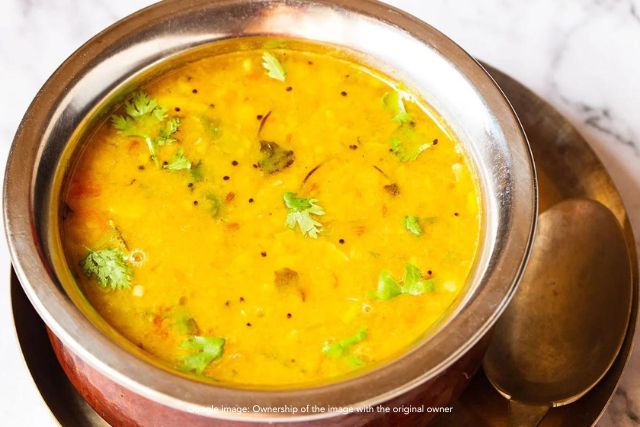
Healthy Split Yellow Moong Dal
Discover the joy of nutritious cooking with our Healthy Dal Recipe, a delightful twist on the traditional Indian dish. This recipe showcases the flavors of split yellow moong dal while focusing on health and wellness. Made with minimal oil and a balanced mix of spices, it offers both comfort and essential nutrients. Lentils are known for their high protein content, making this dish a satisfying option for those seeking a wholesome meal. Perfect for special occasions like Janmashtami, this Healthy Dal is not only delicious but also supports heart health. Let’s dive into the preparation of this nutritious dish that’s ideal for family gatherings or everyday meals.
OUR HEALTHY DAL RECIPE
Ingredients: 1 cup split yellow moong dal 1 onion, finely chopped 2 tomatoes, chopped 1 green chili, slit 1 teaspoon ginger-garlic paste 1/2 teaspoon turmeric powder 1/2 teaspoon cumin seeds 1/2 teaspoon mustard seeds 1/2 teaspoon coriander powder 1/2 teaspoon garam masala Fresh cilantro for garnish Salt to taste 2 cups water
Preparation:
- Rinse 1 cup of split yellow moong dal under cold water until the water runs clear to remove excess starch.
- In a pot, add the washed dal along with 2 cups of water and bring it to a boil.
- Once boiling, reduce the heat and cover the pot, allowing the dal to simmer for about 15-20 minutes, or until tender.
- In a separate pan, heat a small amount of oil over medium heat and add 1/2 teaspoon of mustard seeds and 1/2 teaspoon of cumin seeds.
- Once the seeds start to crackle, add 1 finely chopped onion and sauté until golden brown.
- Stir in 1 teaspoon of ginger-garlic paste and 1 slit green chili, cooking for an additional minute.
- Add 1/2 teaspoon of turmeric powder, 1/2 teaspoon of coriander powder, and salt to taste, mixing well.
- Add the chopped 2 tomatoes and cook until they soften and meld with the spices.
- Pour the cooked dal into the mixture, and add 1/2 teaspoon of garam masala, allowing it to simmer for another 5 minutes to combine flavors.
- Garnish with fresh cilantro before serving, and enjoy your Healthy Dal warm, ideally paired with rice or chapati.
Health Facts
- Protein Powerhouse: Moong dal is rich in protein, making it an excellent choice for vegetarians and vegans.
- Heart Health: The minimal use of oil in this recipe promotes heart health by reducing unhealthy fats.
- Rich in Fiber: This dish is high in dietary fiber, which aids digestion and promotes a healthy gut.
- Low in Calories: A light preparation ensures the dish is low in calories, making it suitable for weight management.
- Antioxidant-Rich: The spices used, such as turmeric and cumin, have antioxidant properties that may help combat inflammation.
- Nutrient Dense: This Healthy Dal is a great source of essential vitamins and minerals like iron, magnesium, and folate.
- Supports Detoxification: Lentils can aid in detoxifying the body due to their fiber content.
- Versatile Serving: It can be paired with various dishes, complementing the traditional Janmashtami meal.
- Balanced Meal: When combined with whole grains like chapati, it offers a complete protein profile.
- Fulfills Festival Nutrition: During Janmashtami, this dish serves as a nourishing option that supports energy levels throughout the festivities.
Approximate Nutrient Breakdown for 100 Grams of This Recipe: Calories: 120 kcal
Carbohydrates: 20g
Protein: 7g
Fat: 1g
Fiber: 5g
Sodium: 200mg
Potassium: 300mg
Calcium: 40mg
Iron: 2mg
Vitamin C: 10mg
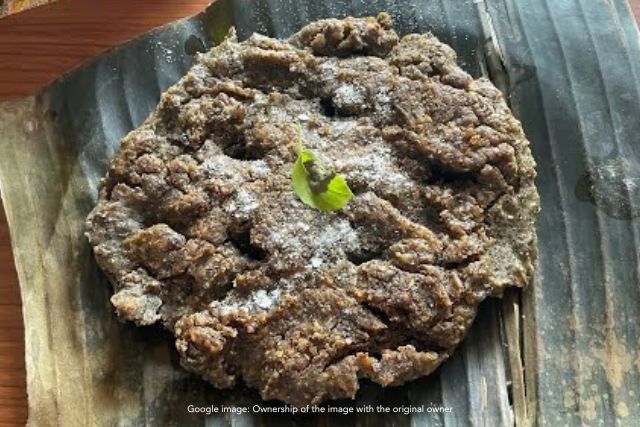
Healthy Suar Pitha
Suar Pitha, a traditional sweet treat, can be enjoyed guilt-free with this healthy twist. By using whole wheat flour and olive oil, this recipe maintains the rich taste and texture while offering a healthier alternative to the classic version made with refined flour and ghee. Whole wheat flour adds a boost of fiber, helping to support digestion and overall health. Olive oil replaces ghee, reducing saturated fats and providing heart-healthy fats. The addition of jaggery, a natural sweetener, not only enhances flavor but also offers various nutritional benefits. Perfect for festive celebrations like Janmashtami, this Suar Pitha lets you indulge in tradition with a modern, health-conscious approach.
Ingredients:
- 1 cup whole wheat flour
- 2 tablespoons olive oil
- 1/4 cup jaggery, grated
- 1/2 cup water
- 1/4 teaspoon cardamom powder
PREPARATION:
- In a mixing bowl, combine 1 cup of whole wheat flour and 1/4 teaspoon of cardamom powder.
- Add 2 tablespoons of olive oil to the flour mixture and mix until the mixture resembles coarse crumbs.
- Gradually add 1/4 cup of grated jaggery to the mixture, ensuring it is evenly distributed.
- Slowly pour in 1/2 cup of water, mixing continuously to form a smooth, pliable dough.
- Cover the dough with a damp cloth and let it rest for 10 minutes.
- Divide the dough into small, equal-sized balls.
- Roll each ball into a thin circle using a rolling pin, dusting with a little flour if necessary.
- Heat a non-stick pan or griddle over medium heat.
- Cook each circle on the pan for about 1-2 minutes on each side, or until golden brown and cooked through.
- Allow the Suar Pithas to cool before serving. Enjoy them warm or at room temperature.
HEALTH FACTS ABOUT WHOLE WHEAT:
- Whole Wheat Flour: Rich in dietary fiber, whole wheat flour aids digestion and helps maintain a healthy digestive system.
- Olive Oil: Contains monounsaturated fats, which are beneficial for heart health and can help reduce cholesterol levels.
- Jaggery: A natural sweetener that provides essential minerals like iron, calcium, and magnesium, boosting overall nutritional value.
- Low in Saturated Fats: By replacing ghee with olive oil, this recipe significantly reduces saturated fat content, promoting better cardiovascular health.
- Antioxidants: Whole wheat flour and jaggery are rich in antioxidants, which help combat oxidative stress and inflammation in the body.
- Mineral-Rich: Jaggery provides a good source of iron, helping to prevent anemia and support overall energy levels.
- Blood Sugar Regulation: Jaggery has a lower glycemic index compared to refined sugars, aiding in better blood sugar management.
- Nutrient-Dense: Whole wheat flour retains more nutrients compared to refined flour, offering more vitamins and minerals.
- Digestive Health: The fiber in whole wheat flour helps promote healthy bowel movements and prevent constipation.
- Festive Enjoyment: This healthy version allows you to partake in traditional Janmashtami celebrations while staying mindful of your health goals.
APPROXIMATE NUTRIENT BREAKDOWN (per 100g):
Calories: 180 kcal
Carbohydrates: 32g
Protein: 4g
Fat: 5g
Fiber: 4g
Sodium: 10mg
Potassium: 80mg
Calcium: 20mg
Iron: 1.5mg
Vitamin C: 0mg
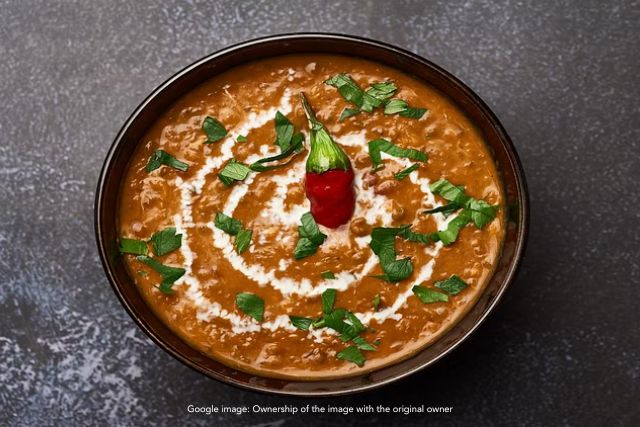
Healthy Urad Dal
Savor the goodness of our Healthy Urad Dal Recipe – a nutritious take on the traditional Urad Dal that retains all the beloved flavors while focusing on health. This version is designed to be lighter, using minimal oil and highlighting the natural flavors of the dal and spices. Perfect for festive occasions like Janmashtami, it offers a wholesome addition to your Chappan Bhog spread. With a balance of rich spices and fresh ingredients, this dish is both satisfying and nourishing. Enjoy a classic favorite with a modern, health-conscious twist. This Healthy Urad Dal promises a guilt-free way to indulge in traditional flavors.
OUR HEALTHY URAD DAL RECIPE
Ingredients:
- 1 cup split urad dal
- 1 onion, finely chopped
- 1 tomato, chopped
- 1 green chili, slit
- 1/2 teaspoon turmeric powder
- 1/2 teaspoon cumin seeds
- 1/2 teaspoon mustard seeds
- 1/2 teaspoon garam masala
- 1/2 teaspoon coriander powder
- Salt to taste
- 2 cups water
Preparation:
- Rinse the split urad dal thoroughly under cold water and soak it for at least 30 minutes.
- Heat a non-stick pan over medium heat and add a small amount of water or a teaspoon of oil.
- Add the cumin seeds and mustard seeds to the pan and let them splutter.
- Add the finely chopped onions and sauté until they turn golden brown.
- Stir in the chopped tomatoes and cook until they become soft and pulpy.
- Add the slit green chili, turmeric powder, coriander powder, and garam masala to the pan. Mix well.
- Drain the soaked urad dal and add it to the pan along with 2 cups of water.
- Bring the mixture to a boil, then reduce the heat to low and let it simmer for about 20-25 minutes, or until the dal is tender.
- Season with salt to taste and adjust the consistency by adding more water if needed.
- Garnish with fresh cilantro before serving.
Health Facts About Urad Dal:
- High in Protein: Urad dal is rich in plant-based protein, making it a great choice for muscle repair and growth.
- Rich in Fiber: It provides ample dietary fiber, aiding in digestion and promoting a feeling of fullness.
- Low in Fat: The recipe uses minimal oil, keeping the fat content low while still delivering flavor.
- Good Source of Iron: Urad dal is high in iron, which is essential for healthy blood circulation and energy levels.
- Supports Heart Health: The use of cumin and mustard seeds provides beneficial compounds that support cardiovascular health.
- Contains Essential Vitamins: The dish is rich in B vitamins, particularly folate, which supports overall metabolic functions.
- Promotes Digestive Health: The high fiber content aids in regulating bowel movements and improving gut health.
- Anti-Inflammatory Properties: Turmeric powder contains curcumin, which has anti-inflammatory properties.
- Supports Metabolism: The spices used in the recipe can help boost metabolism and improve overall digestion.
- Low Glycemic Index: Urad dal has a low glycemic index, making it suitable for maintaining stable blood sugar levels.
Approximate Nutrient Breakdown for 100 Grams of This Recipe:
Calories: 150 kcal
Carbohydrates: 24g
Protein: 10g
Fat: 1g
Fiber: 6g
Sodium: 200mg
Potassium: 350mg
Calcium: 60mg
Iron: 3mg
Vitamin C: 7mg
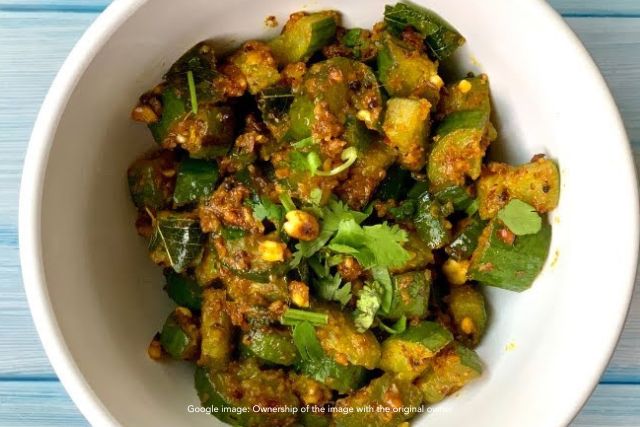
Healthy Vegetable Khata
Get ready to enjoy a healthier twist on the traditional Khata with our updated recipe! This dish, known for its tangy and spicy flavors, gets a nutritious makeover while retaining all its beloved taste. We use fresh ingredients and a blend of wholesome spices to ensure that you enjoy a lighter, yet flavorful, version of this classic dish. Ideal for festive celebrations, this healthier Khata provides a guilt-free way to savor traditional flavors with a modern touch!
Ingredients:
2 cups chopped tomatoes
1 cup chopped cucumbers
1/2 cup grated carrots
1/4 cup chopped cilantro
1 green chili, finely chopped (optional)
1/2 teaspoon cumin seeds
1/2 teaspoon turmeric powder
1/2 teaspoon black salt
1/2 teaspoon regular salt
1 tablespoon lemon juice
Preparation:
- Wash and chop the tomatoes and cucumbers into bite-sized pieces.
- Grate the carrots and place them in a mixing bowl.
- Add the chopped tomatoes and cucumbers to the bowl with the grated carrots.
- Finely chop the green chili (if using) and add it to the bowl.
- In a small pan, dry roast the cumin seeds until fragrant.
- Add the roasted cumin seeds, turmeric powder, black salt, and regular salt to the vegetables.
- Pour in the lemon juice and mix well to combine all the flavors.
- Stir in the chopped cilantro for a fresh garnish.
- Let the mixture sit for about 10 minutes to allow the flavors to meld together.
- Serve chilled or at room temperature as a refreshing side dish.
Health Facts About Khata:
- Rich in Vitamins: The tomatoes, cucumbers, and carrots provide a good source of vitamins A and C, which support immune health.
- High in Fiber: Carrots and cucumbers are high in dietary fiber, promoting digestive health and satiety.
- Low in Calories: This dish is light and low in calories, making it a suitable option for weight management.
- Hydrating: Cucumbers have high water content, aiding in hydration.
- Antioxidant-Rich: Tomatoes and carrots are rich in antioxidants that help fight oxidative stress.
- Supports Heart Health: The use of black salt provides minerals without the high sodium content of regular salt.
- Improves Digestion: The combination of fresh vegetables and spices can aid in digestion.
- Anti-Inflammatory Properties: Turmeric is known for its anti-inflammatory benefits.
- Boosts Skin Health: The vitamins and minerals from the vegetables contribute to healthy, glowing skin.
- Balances Blood Sugar: Low in glycemic index, this dish helps in maintaining balanced blood sugar levels.
Approximate Nutrient Breakdown of This Recipe for 100 Grams:
Calories: 50 kcal
Carbohydrates: 12g
Protein: 1g
Fat: 0.5g
Fiber: 3g
Sodium: 200mg
Potassium: 250mg
Calcium: 30mg
Iron: 0.5mg
Vitamin C: 25mg
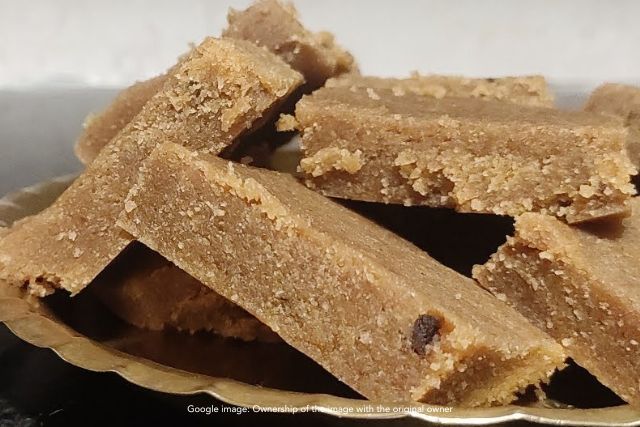
Jagannath Ballav
Jagannath Ballav is a traditional snack that’s been reimagined to offer a healthier twist without compromising on its delightful taste. Originating as part of the Chappan Bhog during Janmashtami, this treat is typically enjoyed during festive celebrations. Our variant incorporates whole wheat flour and jaggery powder, which not only enhance the flavor but also boost its nutritional profile. By using these wholesome ingredients, we ensure that this classic delight is lighter and better for you. The addition of ghee adds a rich, authentic taste while keeping the recipe healthy. Perfect for any festival or as a nutritious snack, Jagannath Ballav is both satisfying and beneficial.
Ingredients:
- 1 cup whole wheat flour
- 1/2 cup jaggery powder
- 2 tablespoons ghee
Preparation:
- Heat 2 tablespoons of ghee in a pan over medium heat.
- Add 1 cup of whole wheat flour to the pan and roast it gently until it turns golden brown and releases a nutty aroma.
- Remove the roasted flour from the pan and let it cool slightly.
- In a separate bowl, combine 1/2 cup of jaggery powder with a little warm water to form a smooth paste.
- Gradually mix the jaggery paste into the roasted flour, stirring continuously to avoid lumps.
- Continue mixing until the mixture is well combined and forms a dough-like consistency.
- Let the dough rest for about 10 minutes to allow the flavors to meld.
- Shape the dough into small, round balls or any preferred shape.
- Heat a little more ghee in the pan and lightly fry the shaped dough balls until they are golden and crispy on all sides.
- Allow the balls to cool before serving, and enjoy your healthier version of Jagannath Ballav!
Health Facts:
- Whole Wheat Flour: Provides more fiber and nutrients compared to refined flour, aiding digestion and promoting heart health.
- Jaggery Powder: Acts as a natural sweetener and is rich in minerals like iron and calcium, which can help improve blood health and strengthen bones.
- Ghee: Contains healthy fats that support brain function and provide essential fatty acids for overall health.
- Low Glycemic Index: The combination of whole wheat flour and jaggery has a lower glycemic index compared to processed sugars, helping maintain stable blood sugar levels.
- Rich in Antioxidants: Jaggery has antioxidants that help combat oxidative stress and improve immunity.
- Boosts Energy: The natural sugars in jaggery provide a quick energy boost without the crash associated with refined sugars.
- Supports Metabolism: Whole wheat flour and ghee contribute to a healthy metabolism and can help manage weight when consumed in moderation.
- Improves Skin Health: The nutrients in ghee and jaggery can promote healthy, glowing skin and reduce signs of aging.
- Enhances Digestive Health: The fiber in whole wheat flour aids in regular bowel movements and prevents constipation.
- Traditional Benefits: Consuming this recipe during Janmashtami provides a culturally relevant way to enjoy traditional foods with added health benefits.
Approximate Nutrient Breakdown (per 100 grams):
- Calories: 240 kcal
- Carbohydrates: 40g
- Protein: 3g Fat: 9g
- Fiber: 4g
- Sodium: 5mg
- Potassium: 90mg
- Calcium: 20mg
- Iron: 2mg
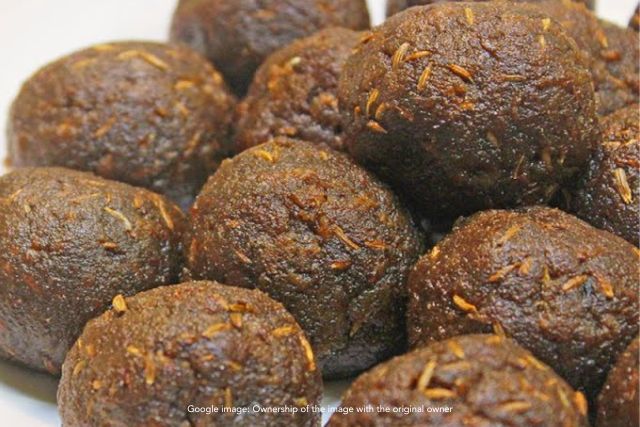
Jeera Ladoo
Delight in a healthier take on the traditional Jeera Ladoo with our nutritious recipe that brings together wholesome ingredients for a delectable treat. This version combines the richness of whole wheat flour with the natural sweetness of jaggery and the aromatic touch of roasted cumin seeds. Perfect for Janmashtami celebrations, these laddus are not only delicious but also offer numerous health benefits. The use of ghee in moderation adds a rich flavor while keeping the recipe light and satisfying. Whether enjoyed as a festive snack or a daily treat, these laddus provide a guilt-free indulgence. Elevate your celebrations with this healthier variant that supports both taste and well-being.
Ingredients:
- 1 cup whole wheat flour
- 1/4 cup jaggery powder
- 1 tablespoon ghee
- 1 tablespoon roasted cumin seeds
- 1/4 teaspoon salt
Preparation:
- Heat a pan over medium heat.
- Add whole wheat flour to the pan.
- Roast the flour, stirring continuously, until it becomes fragrant and slightly golden.
- Remove the flour from the pan and set it aside to cool.
- In the same pan, add ghee and melt it over medium heat.
- Once the ghee is melted, return the roasted flour to the pan.
- Stir in jaggery powder and mix well until it is fully combined.
- Add roasted cumin seeds and salt to the mixture.
- Continue to stir until the mixture starts to come together and forms a dough-like consistency.
- Shape the mixture into small laddus while still warm and allow them to cool completely.
Health Facts:
- Whole Wheat Flour: Provides dietary fiber that supports digestive health and helps maintain stable blood sugar levels.
- Cumin Seeds: Aid in digestion, alleviate bloating, and add a distinct flavor to the laddus.
- Jaggery: Offers a natural sweetener alternative to refined sugar, with added minerals like iron and magnesium.
- Ghee: Contains healthy fats that can enhance nutrient absorption and support overall well-being when used in moderation.
- Moderate Sweetener: The use of jaggery instead of refined sugar helps reduce the glycemic index of the laddus.
- Nutrient-Rich Ingredients: The combination of whole wheat flour, jaggery, and cumin seeds provides essential vitamins and minerals.
- Low in Refined Sugar: Reduces the risk of blood sugar spikes and supports better metabolic health.
- Fiber Content: Whole wheat flour adds dietary fiber that contributes to a feeling of fullness and aids in digestion.
- Antioxidants: Cumin seeds contain antioxidants that help protect cells from damage.
- Energy Boost: The natural sugars in jaggery and the healthy fats in ghee provide a quick source of energy.
Approximate Nutrient Breakdown (per 100 grams):
- Calories: 230 kcal
- Carbohydrates: 40g
- Protein: 3g
- Fat: 8g Fiber: 4g
- Sodium: 50mg
- Potassium: 100mg
- Calcium: 25mg
- Iron: 2mg
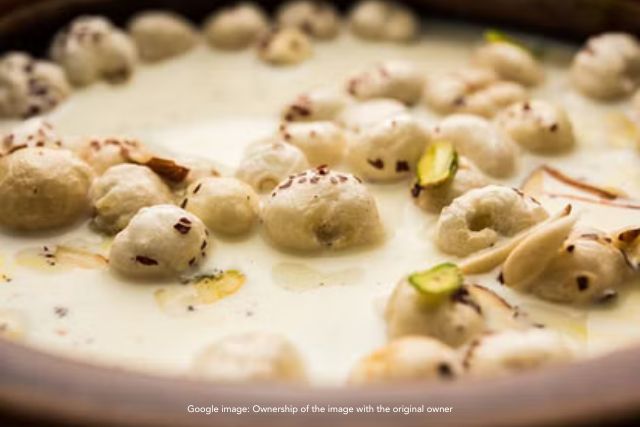
Low Fat Milk Khua
Get ready to enjoy a healthier twist on the traditional Khua with our updated recipe! This classic sweet dish is made lighter by using low-fat milk and a touch of jaggery for natural sweetness. Perfect for Janmashtami, this version retains the delicious essence of the original while being mindful of calorie and fat content.
Our healthy Khua offers a satisfying, nutritious option that’s both comforting and festive. This updated recipe ensures you can celebrate with a traditional favorite, while still aligning with your health goals.
Whether you're hosting a celebration or simply indulging in a festive treat, this Khua is a delightful choice.
Ingredients:
- 2 cups low-fat milk,
- 2 tbsp jaggery
Preparation:
- Pour 2 cups of low-fat milk into a heavy-bottomed pan.
- Heat the milk over medium heat, stirring continuously.
- Bring the milk to a gentle boil.
- Reduce the heat and let the milk simmer, stirring frequently.
- Continue to cook until the milk thickens to a custard-like consistency.
- Remove the pan from heat.
- Stir in 2 tablespoons of jaggery until fully dissolved.
- Let the mixture cool slightly.
- Transfer to serving dishes.
- Refrigerate until chilled before serving.
Health Facts:
- Low-fat milk reduces overall calorie and fat intake.
- Jaggery provides natural sweetness and contains iron and minerals.
- This version is lower in saturated fats compared to using full-fat milk.
- Provides a good source of protein from the milk.
- Jaggery can aid in digestion and detoxification.
- Lower in calories compared to traditional recipes that use sugar and full-fat milk.
- Rich in calcium and vitamin D from the milk, supporting bone health.
- Aids in muscle repair and growth due to the protein content.
- Lower fat content supports heart health.
- The use of jaggery instead of refined sugar offers additional nutrients.
Nutrient Breakdown per Serving:
- Calories: 100 kcal
- Carbohydrates: 18g
- Protein: 4g
- Fat: 2g
- Fiber: 0g
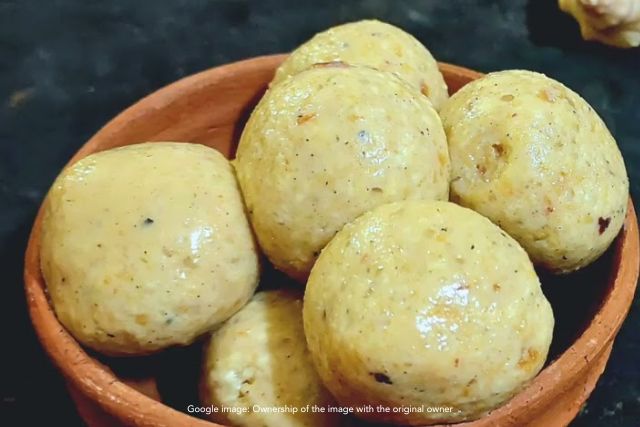
Low Fat Milk Khua Manda
Relish a healthier version of Khua Manda, a traditional festive treat that combines milk, wheat, and ghee in a wholesome way. This updated recipe replaces full-fat milk with low-fat milk and maintains the use of whole wheat to ensure a nutritious option for your celebrations. With a touch of jaggery for natural sweetness, this Khua Manda is both delicious and lower in fat and refined sugars. Ideal for Janmashtami, this recipe retains the rich flavors of the traditional dish while aligning with healthier eating goals. Enjoy a treat that's both festive and mindful of your well-being. Indulge in this lighter version of Khua Manda and celebrate the festival with a nutritious twist!
OUR HEALTHY KHUA MANDA RECIPE
Ingredients:
- 1 cup low-fat milk
- 1/2 cup whole wheat flour
- 1 tbsp jaggery
- 1 tsp ghee (clarified butter)
Preparation:
- Heat a non-stick pan over medium heat and add the whole wheat flour.
- Dry roast the flour until it turns golden brown and emits a nutty aroma.
- In a separate pan, bring the low-fat milk and water to a gentle boil.
- Gradually add the roasted flour to the milk while stirring continuously to avoid lumps.
- Add jaggery to the mixture and continue to cook, stirring until the jaggery dissolves completely.
- Reduce the heat and cook the mixture until it thickens and starts to leave the sides of the pan.
- Stir in cardamom powder for added flavor.
- If using, fold in chopped nuts and coconut flakes.
- Grease a dish with a little ghee and pour the mixture into it.
- Allow it to cool and set before cutting into pieces.
HEALTH FACTS ABOUT WHOLE WHEAT:
- Low-fat milk provides calcium and vitamin D with reduced saturated fat content.
- Whole wheat flour adds dietary fiber, which aids in digestion and promotes satiety.
- Jaggery is a natural sweetener that contains iron and antioxidants compared to refined sugar.
- Using nuts adds healthy fats and additional protein to the dish.
- Coconut flakes provide fiber and healthy fats, enhancing the nutritional profile.
- This version reduces calorie content by avoiding ghee and full-fat milk.
- Whole wheat flour supports heart health due to its high fiber content.
- The dish has a lower glycemic index compared to traditional recipes with refined sugars.
- Cardamom has digestive benefits and adds a fragrant touch without extra calories.
- This healthier Khua Manda still offers the rich taste of the traditional dish while being mindful of dietary needs.
APPROXIMATE NUTRIENT BREAKDOWN PER 100 GRAMS:
- Calories: 170 kcal
- Carbohydrates: 25g
- Protein: 5g
- Fat: 4g
- Fiber: 4g
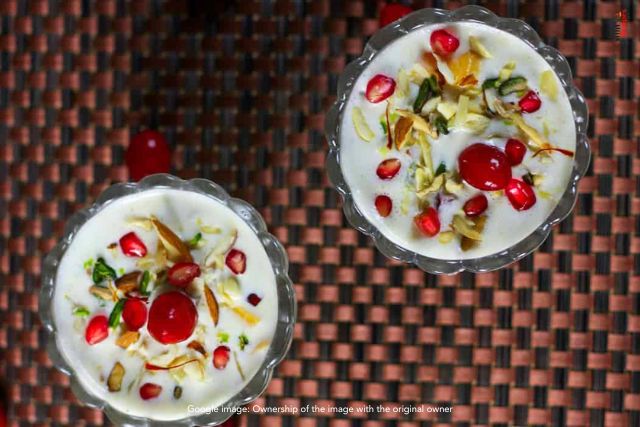
Low Fat Milk Papudi
Indulge in a lighter take on the classic Papudi with our healthy version, perfect for celebrating Janmashtami while keeping your diet on track. Traditional Papudi is known for its rich, creamy texture, but using low-fat cream helps cut down on saturated fats, making it a more heart-healthy option. By incorporating honey, a natural sweetener, you can enjoy the dish's sweetness without added refined sugars. This healthier version maintains the festive flavor and creamy delight of the original. Ideal for those mindful of their fat and sugar intake, this Papudi allows you to savor a traditional treat in a more nutritious way. Perfect for Janmashtami celebrations, it aligns with health goals without compromising on taste.
Ingredients:
- 1 cup low-fat milk cream,
- 2 tbsp honey
Preparation:
- Begin by measuring out 1 cup of low-fat milk cream.
- Pour the low-fat cream into a small saucepan.
- Heat the cream over medium-low heat, stirring occasionally.
- Gradually add 2 tablespoons of honey to the cream.
- Continue to stir as the honey dissolves into the cream.
- Allow the mixture to simmer gently, avoiding a full boil.
- Stir frequently to prevent sticking or burning.
- Simmer until the cream reaches a creamy, slightly thickened consistency.
- Remove the saucepan from heat and let the mixture cool slightly.
- Transfer to a serving dish and refrigerate until ready to serve.
Health Facts:
- Low-fat cream reduces the overall saturated fat content compared to regular cream.
- Honey is a natural sweetener that contains antioxidants and may offer some health benefits.
- Using low-fat cream helps lower calorie intake, which is beneficial for weight management.
- Honey has a lower glycemic index compared to refined sugar, which may help in better blood sugar control.
- This version of Papudi provides a source of calcium from the cream, which is essential for bone health.
- Low-fat cream maintains a lower cholesterol level, contributing to heart health.
- Honey contains trace amounts of vitamins and minerals that can contribute to overall wellness.
- The recipe avoids refined sugars, reducing the risk of sugar spikes and crashes.
- Low-fat cream and honey together offer a balanced option that can satisfy sweet cravings healthily.
- This healthier Papudi aligns with dietary goals during Janmashtami, offering a festive treat that's both delicious and nutritious.
Nutrient Breakdown per Serving:
Calories: 80 kcal
Carbohydrates: 12g
Protein: 2g
Fat: 3g
Fiber: 0g
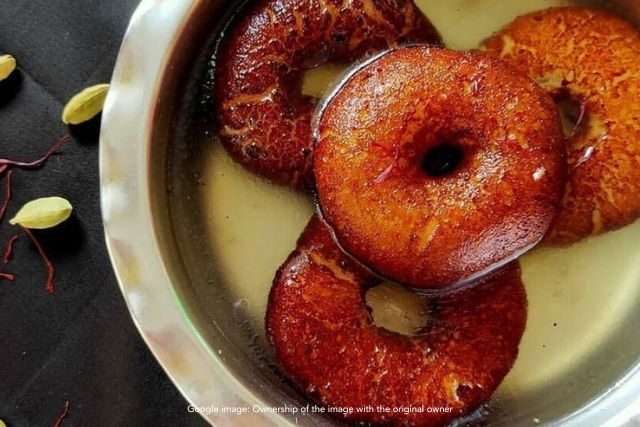
Low Fat Paneer Tadia
Indulge in a healthier twist on the traditional Tadia with our revised recipe, perfect for celebrating Janmashtami! Traditionally made with fresh cheese, sugar, and ghee, this version uses low-fat paneer and coconut sugar to offer a more nutritious option. It's a delightful treat that maintains the classic flavor while aligning with your health-conscious goals. This healthy variant is not only delicious but also provides essential nutrients without compromising on taste. Whether you're observing Janmashtami or simply enjoying a festive treat, this recipe is sure to satisfy. Enjoy the festive spirit with a healthier take on this traditional favorite!
OUR HEALTHY TADIA RECIPE
Ingredients:
- 1 cup low-fat paneer (fresh cheese)
- 1/4 cup coconut sugar
- 1 tbsp ghee (clarified butter)
Preparation:
- Crumble the low-fat paneer into small pieces.
- Heat the ghee in a non-stick pan over medium heat.
- Add the crumbled paneer to the pan and sauté until it turns golden brown.
- Reduce the heat to low and add the coconut sugar.
- Stir the mixture until the coconut sugar melts and blends evenly with the paneer.
- Continue to cook for a few more minutes, allowing the flavors to meld together.
- Remove from heat and let the mixture cool slightly.
- Shape the mixture into small balls using your hands.
- Place the balls on a plate and allow them to cool completely.
- Serve the Tadia warm or at room temperature.
HEALTH FACTS ABOUT PANEER:
- High in Protein: Low-fat paneer provides a substantial amount of protein essential for muscle health and repair.
- Calcium-Rich: Paneer contains calcium, which is crucial for maintaining strong bones and teeth.
- Lower in Fat: Using low-fat paneer reduces the overall fat content compared to traditional recipes.
- Natural Sweetener: Coconut sugar has a lower glycemic index than refined sugar, which is better for blood sugar control.
- Rich in Healthy Fats: Ghee, though used in moderation, provides beneficial fats and can aid in absorption of fat-soluble vitamins.
- Supports Bone Health: The calcium in paneer helps strengthen bones and prevent osteoporosis.
- Boosts Metabolism: Protein and healthy fats can help boost metabolism and support weight management.
- Improves Digestion: Ghee aids in digestion and can help soothe the digestive tract.
- Enhances Skin Health: The combination of healthy fats and protein promotes healthy, glowing skin.
- Supports Overall Wellness: This healthier version provides essential nutrients without excessive calories or refined sugars.
APPROXIMATE NUTRIENT BREAKDOWN PER 100 GRAMS:
- Calories: 150 kcal
- Carbohydrates: 15g
- Protein: 10g
- Fat: 5g
- Fiber: 1g
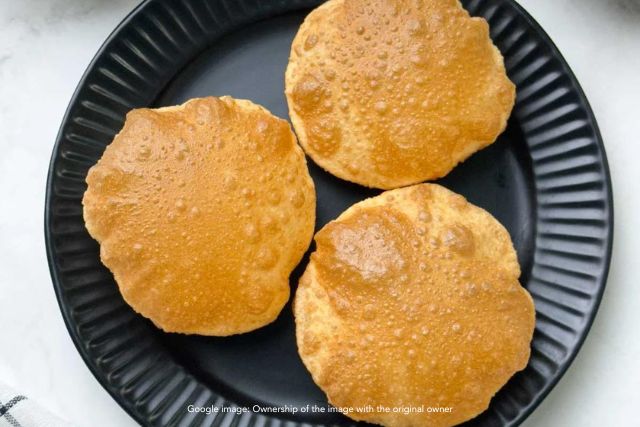
Low Fat Puri
Puri, a beloved Indian bread traditionally enjoyed during festivals and special occasions, can be made healthier with a few simple adjustments. Instead of frying, which adds unnecessary calories and fat, baking offers a lighter alternative. By using whole wheat flour, you boost the nutritional value, increasing fiber and essential nutrients. This variation is not only delicious but also aligns better with health-conscious dietary choices. Incorporating olive oil adds a touch of heart-healthy fat, making this recipe a more balanced option. Perfect for celebrations like Janmashtami, this baked puri can be a guilt-free treat for the whole family.
Ingredients: 1 cup whole wheat flour, 1 tbsp olive oil, a pinch of salt, water as needed
Preparation:
- Preheat your oven to 375°F (190°C).
- In a mixing bowl, combine 1 cup of whole wheat flour and a pinch of salt.
- Add 1 tablespoon of olive oil to the flour mixture.
- Gradually add water, a little at a time, until the dough comes together and is soft but not sticky.
- Knead the dough for about 5 minutes until it is smooth and elastic.
- Cover the dough with a damp cloth and let it rest for 15-20 minutes.
- Divide the dough into small, equal-sized balls.
- Roll each ball into a flat circle about 1/8 inch thick using a rolling pin.
- Place the rolled circles on a baking sheet lined with parchment paper.
- Bake for 10-12 minutes or until the puris are golden brown and slightly crisp.
Health Facts:
- Whole Wheat Flour: Provides more fiber and nutrients compared to refined flour, aiding digestion and maintaining blood sugar levels.
- Baking vs. Frying: Baking reduces the fat content and calorie count, making it a heart-healthier choice.
- Olive Oil: Contains monounsaturated fats that support cardiovascular health and may help lower bad cholesterol.
- Fiber Content: Whole wheat flour increases fiber intake, which is beneficial for digestive health and can aid in weight management.
- Low Glycemic Index: Whole wheat flour has a lower glycemic index compared to refined flour, helping to regulate blood sugar levels.
- Nutrient-Rich: Whole wheat flour is rich in essential vitamins and minerals like B vitamins, iron, and magnesium.
- Anti-Inflammatory Properties: Olive oil has anti-inflammatory properties that can benefit overall health and may help reduce inflammation.
- Heart Health: The combination of whole wheat flour and olive oil supports heart health, which is important during festive celebrations.
- Energy Boost: Whole grains provide sustained energy, making these puris a great option for active and busy festival days.
- Traditional and Nutritious: This healthier puri version maintains the traditional essence of Chappan Bhog while offering a more nutritious option for Janmashtami.
Nutrient Breakdown per Serving: Calories: 80 kcal
Carbohydrates: 15g
Protein: 2g
Fat: 2g
Fiber: 2g
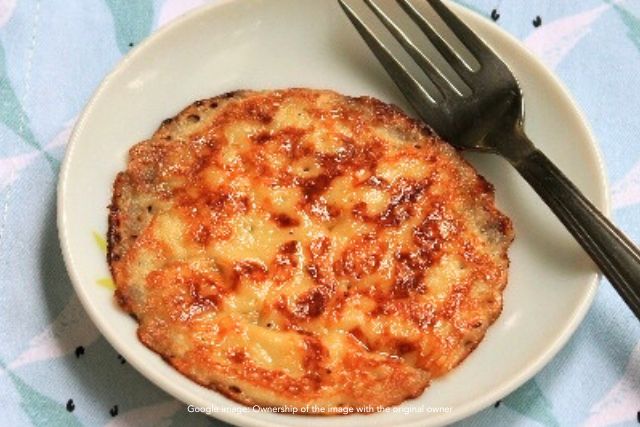
Milk and Coconut Sarapulli
Experience a refreshing twist on the traditional Sarapulli with our healthier recipe! Traditionally, Sarapulli is made by boiling pure milk for hours, but this version uses low-fat milk and natural sweeteners for a lighter, yet equally delicious treat. Perfect for Janmashtami celebrations, this nutritious variant maintains the essence of the original dish while making it more heart-friendly. Low-fat milk provides essential nutrients without the added calories, and coconut sugar adds a touch of natural sweetness. Enjoy this wholesome Sarapulli as a healthy dessert option that's both satisfying and festive. Treat yourself and your loved ones to this guilt-free indulgence that fits perfectly into your holiday spread!
OUR HEALTHY SARAPULLI RECIPE
Ingredients:
- 4 cups low-fat milk
- 1/4 cup coconut sugar
- 1/2 tsp cardamom powder
Preparation:
- Pour the low-fat milk into a large, heavy-bottomed pan.
- Heat the milk over medium flame, stirring frequently.
- Continue to boil the milk until it reduces by half.
- Add the coconut sugar and stir until fully dissolved.
- Sprinkle in the cardamom powder and mix well.
- Keep cooking until the mixture thickens and starts to form a layer.
- Remove from heat and allow it to cool slightly.
- Pour the thickened mixture into a large, pizza-shaped pan.
- Spread it evenly and let it cool completely at room temperature.
- Once cooled, cut into slices and serve chilled.
HEALTH FACTS ABOUT LOW-FAT MILK:
- Low-fat milk is high in calcium, essential for strong bones and teeth.
- It provides protein necessary for muscle repair and growth.
- Coconut sugar is a natural sweetener with a lower glycemic index compared to refined sugar.
- The recipe is lower in calories compared to traditional milk-based sweets.
- Cardamom is known for its digestive benefits and can help soothe the stomach.
- Low-fat milk contains fewer saturated fats, promoting heart health.
- Coconut sugar contains trace minerals like potassium and iron.
- This version of Sarapulli is less likely to cause blood sugar spikes.
- The use of natural sweeteners supports better overall metabolic health.
- This dish is suitable for those looking to manage their weight while enjoying a festive treat.
APPROXIMATE NUTRIENT BREAKDOWN PER 100 GRAMS:
- Calories: 140 kcal
- Carbohydrates: 20g
- Protein: 8g
- Fat: 3g
- Fiber: 0g
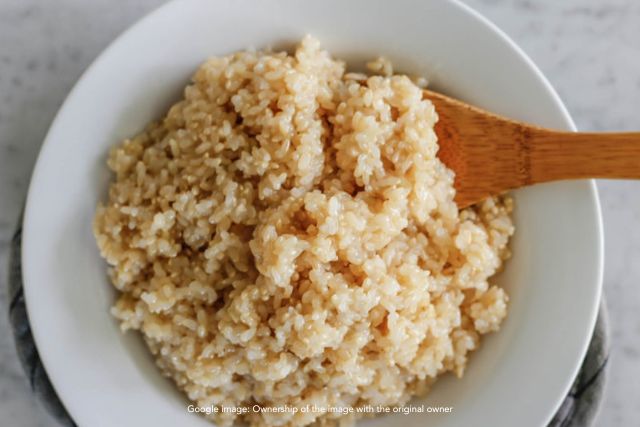
Mitha Pakhal with Jaggery
Transform Mitha Pakhal into a healthier option by using brown rice and natural sweeteners like honey or jaggery, offering a delightful and nutritious twist on this traditional dish.
Ingredients: 1 cup brown rice, rinsed 2 cups water 2 tablespoons jaggery (or honey) A pinch of cardamom powder
Preparation: Cook the brown rice in water until tender. Dissolve the jaggery in a little warm water and mix into the cooked rice. Add cardamom powder for flavor. Serve chilled or at room temperature.
Health Facts:
- Brown rice provides more fiber and nutrients compared to white rice.
- Jaggery is a healthier alternative to refined sugar.
- The dish has a low glycemic index, aiding in blood sugar control.
Nutrient Breakdown (per 100 grams): Calories: 100 kcal
Carbohydrates: 22g
Protein: 2g
Fat: 1g
Fiber: 2g
Sodium: 5mg
Potassium: 40mg
Calcium: 15mg
Iron: 0.8mg
Vitamin C: 0mg
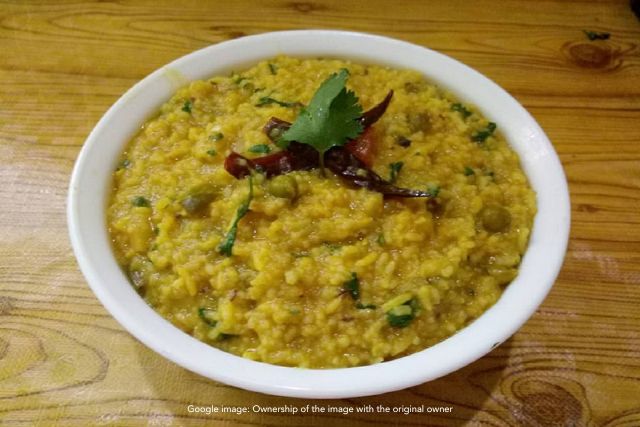
Quinoa Khechedi
Enjoy a nutritious and hearty version of Khechedi, a classic rice and lentil dish. This recipe uses quinoa instead of rice and adds an array of vegetables for extra nutrients, making it a wholesome choice for your festive feast.
Ingredients: 1 cup quinoa, rinsed 1/2 cup split yellow moong dal 1 onion, chopped 1 tomato, chopped 1 carrot, diced 1/2 cup green peas 1 teaspoon turmeric powder 1 teaspoon cumin seeds Salt to taste 2 tablespoons cilantro, chopped 4 cups water
Preparation: Toast the quinoa and moong dal in a pot until aromatic. Add water, vegetables, turmeric, cumin seeds, and salt. Cook until quinoa and lentils are tender. Garnish with chopped cilantro and serve hot.
Health Facts:
- Quinoa is rich in protein and essential amino acids.
- Lentils are high in fiber and support digestive health.
- The dish is packed with vitamins and minerals from the vegetables.
Nutrient Breakdown (per 100 grams): Calories: 120 kcal
Carbohydrates: 20g
Protein: 5g
Fat: 2g
Fiber: 4g
Sodium: 50mg
Potassium: 150mg
Calcium: 20mg
Iron: 1.5mg
Vitamin C: 5mg
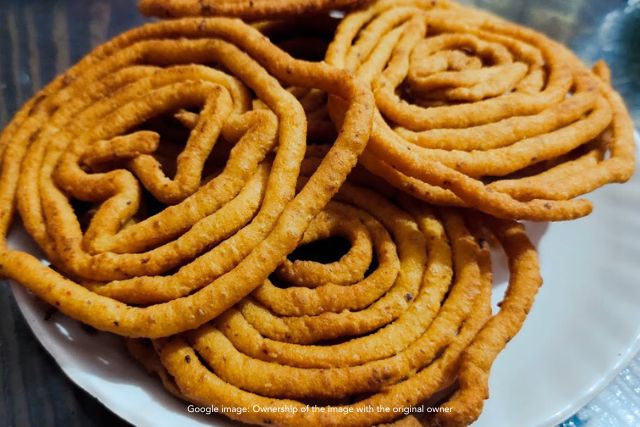
Rice Flour Jhilli
Discover a healthier twist on the traditional Jhilli with our modern variant, perfect for those seeking a nutritious treat. This recipe incorporates rice flour, coconut oil, and jaggery, offering a wholesome alternative to the conventional version. By using these ingredients, we've reduced refined sugars and unhealthy fats, making it a smarter choice for your diet. The crispy texture and sweet flavor remain intact, providing a satisfying snack that's also good for you. Ideal for celebrations like Janmashtami, this Jhilli version maintains the festive spirit while aligning with health-conscious choices. Enjoy this healthier snack without compromising on taste or tradition.
Ingredients:
- 1 cup rice flour
- 2 tablespoons coconut oil
- 1/4 cup jaggery syrup
- 1/2 teaspoon fennel seeds
PREPARATION:
- In a large mixing bowl, combine 1 cup of rice flour and 1/2 teaspoon of fennel seeds.
- Gently heat 2 tablespoons of coconut oil in a small pan until melted.
- Pour the melted coconut oil into the rice flour mixture and stir to combine.
- Gradually add 1/4 cup of jaggery syrup to the mixture, stirring continuously until a dough forms.
- Once the dough is well combined, cover it with a damp cloth and let it rest for about 10 minutes.
- Preheat a deep frying pan with enough coconut oil to submerge the Jhilli.
- Take small portions of the dough and roll them into thin, flat circles.
- Carefully slide the dough circles into the hot oil and fry until they are golden brown and crispy.
- Remove the fried Jhilli from the oil and place them on a paper towel to drain excess oil.
- Allow the Jhilli to cool before serving. Enjoy your healthier snack!
HEALTH FACTS ABOUT RICE FLOUR AND JAGGERY:
- Rice Flour: A good source of complex carbohydrates and gluten-free, making it suitable for those with gluten sensitivities.
- Coconut Oil: Contains medium-chain triglycerides (MCTs), which can support metabolism and provide a quick source of energy.
- Jaggery: Provides essential minerals like iron, calcium, and magnesium, which can improve overall health and energy levels.
- Fennel Seeds: Known for their digestive benefits, they can help in reducing bloating and improving digestion.
- Lower Sugar: Using jaggery instead of refined sugar reduces the glycemic index, which is beneficial for blood sugar management.
- Healthy Fats: Coconut oil contains healthy fats that are less likely to contribute to heart disease compared to other oils.
- Antioxidants: Jaggery has antioxidant properties that help in fighting oxidative stress and inflammation.
- Rich in Fiber: Rice flour is relatively high in fiber, which can support digestive health and prevent constipation.
- Energy Boost: The combination of jaggery and coconut oil provides sustained energy, making it an excellent choice for festive occasions.
- Traditional and Nutritious: This healthy Jhilli variant maintains the essence of traditional snacks while offering better nutritional benefits, aligning with the celebratory spirit of Janmashtami.
APPROXIMATE NUTRIENT BREAKDOWN (per 100g):
Calories: 190 kcal
Carbohydrates: 35g
Protein: 2g
Fat: 6g
Fiber: 2g
Sodium: 10mg
Potassium: 50mg
Calcium: 20mg
Iron: 1mg
Vitamin C: 0mg
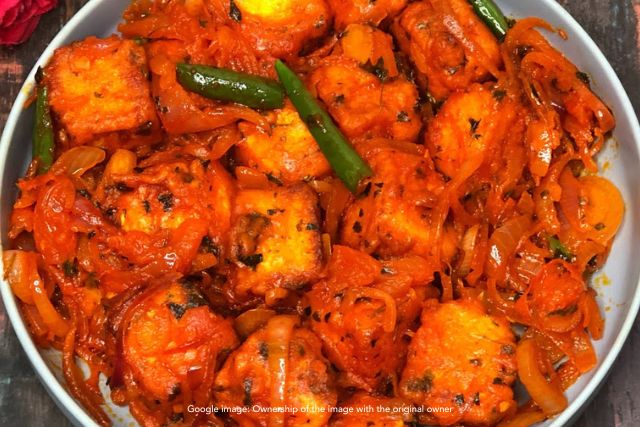
Rice Flour Kanti
Kanti is a traditional Indian dish often enjoyed during festive occasions, known for its rich flavor and cultural significance. This healthy variant of Kanti transforms the classic recipe into a more nutritious treat while maintaining the beloved taste. By substituting rice flour for refined flour, coconut oil for ghee, and jaggery for sugar, this recipe offers a healthier indulgence. The addition of cardamom powder enhances the aroma and flavor, making it both delicious and wholesome. Perfect for celebrations like Janmashtami, this variant allows you to enjoy traditional flavors with a modern, health-conscious twist. Celebrate with a dish that aligns with your dietary goals without compromising on taste.
Ingredients:
- 1 cup rice flour
- 2 tablespoons coconut oil
- 1/4 cup jaggery, grated
- 1/2 teaspoon cardamom powder
PREPARATION:
- Preheat your pan over low heat.
- Add 2 tablespoons of coconut oil and let it melt.
- In a separate bowl, mix 1 cup of rice flour with 1/4 cup of grated jaggery.
- Gradually add water to the flour mixture until you achieve a smooth, batter-like consistency.
- Pour the batter into the pan and spread it evenly.
- Cook on low heat for about 5-7 minutes, stirring occasionally to prevent sticking.
- Add 1/2 teaspoon of cardamom powder to the mixture.
- Continue to cook until the mixture thickens and begins to leave the sides of the pan.
- Remove from heat and let it cool slightly before transferring to a serving dish.
- Cut into desired shapes and serve warm or at room temperature.
HEALTH FACTS ABOUT RICE FLOUR AND JAGGERY:
- Rice Flour: Unlike refined flour, rice flour is gluten-free and easily digestible, making it a good choice for those with gluten sensitivity.
- Coconut Oil: Rich in medium-chain triglycerides (MCTs), coconut oil supports metabolism and provides a quick energy boost.
- Jaggery: Contains essential minerals like iron and calcium, and has a lower glycemic index than refined sugar, making it a healthier sweetener.
- Cardamom: Known for its anti-inflammatory properties, cardamom helps in digestion and can improve oral health.
- Low Glycemic Index: The combination of jaggery and rice flour helps in stabilizing blood sugar levels, which is beneficial for maintaining energy.
- Rich in Antioxidants: Jaggery and cardamom are rich in antioxidants, which help combat oxidative stress and reduce inflammation.
- Boosts Immunity: The nutrients in coconut oil and cardamom contribute to a stronger immune system.
- Digestive Health: The fiber content in rice flour and cardamom aids in digestive health and helps prevent constipation.
- Energy Boost: The MCTs in coconut oil provide a quick source of energy, which is particularly useful during fasting periods.
- Traditional Benefits: During Janmashtami, Kanti made with this healthy recipe aligns with the tradition of offering wholesome foods, reflecting both respect for dietary practices and celebration of the festival.
APPROXIMATE NUTRIENT BREAKDOWN (per 100g):
Calories: 185 kcal
Carbohydrates: 34g
Protein: 2g
Fat: 5g
Fiber: 2g
Sodium: 10mg
Potassium: 50mg
Calcium: 20mg
Iron: 1mg
Vitamin C: 0mg
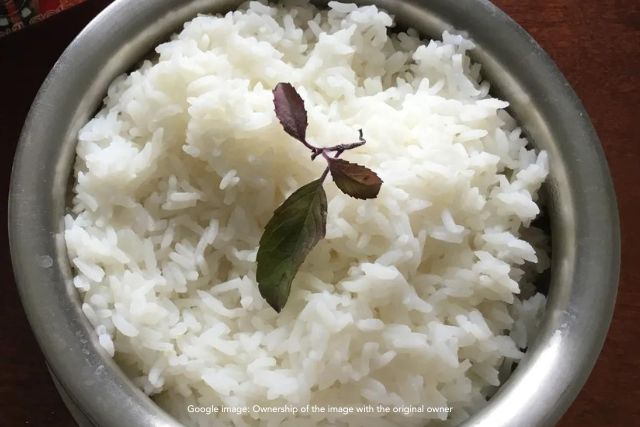
Simple Sadha Anna
Get ready to experience a healthier twist on the traditional Sadha Anna with our nutritious and easy-to-make recipe. This version uses brown rice and avoids the use of added fats, ensuring a simple yet wholesome dish that retains all the essential nutrients of rice.
Ingredients:
- 1 cup brown rice, soaked for 30 minutes and drained
- 4 cups water
- A pinch of salt (optional)
Preparation: Bring the water to a boil in a large pot. Add the soaked brown rice and reduce the heat to a simmer. Cook the rice for 45 minutes, or until tender. Drain any excess water, fluff the rice with a fork, and serve warm.
Health Facts About Brown Rice:
- High in fiber for digestive health.
- Rich in essential minerals like magnesium and phosphorus.
- Contains antioxidants that promote overall health.
- Helps in regulating blood sugar levels.
Approximate Nutrient Breakdown Per 100 Grams:
- Calories: 110 kcal
- Carbohydrates: 23g
- Protein: 2.5g
- Fat: 0.5g
- Fiber: 2g
- Sodium: 5mg
- Potassium: 35mg
- Calcium: 10mg
- Iron: 0.6mg
- Vitamin C: 0mg
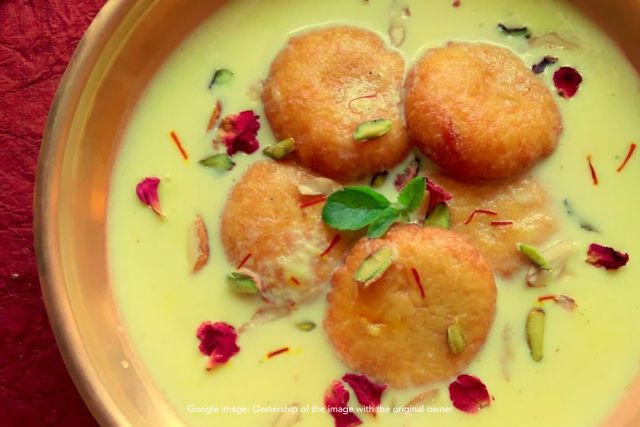
Skimmed Milk Rasabali
Introducing a nutritious twist to the classic Rasabali, a beloved traditional treat often enjoyed during festive celebrations. This healthier variant replaces the usual sugar with jaggery, a natural sweetener that adds a rich, caramel-like flavor and numerous health benefits. By using whole wheat flour instead of refined flour, we increase the fiber content, making it a more wholesome choice. Skimmed milk is used to reduce the fat content while still providing a creamy texture. A touch of cardamom powder adds a fragrant, aromatic element that complements the flavors beautifully. Perfect for Chappan Bhog during Janmashtami, this recipe allows you to indulge in a sweet treat without compromising your health goals.
Ingredients:
- 1 cup skimmed milk
- 1/4 cup whole wheat flour
- 1/4 cup jaggery
- 1/2 tsp cardamom powder
- 1 tsp ghee (clarified butter)
Preparation:
- Heat 1 tsp of ghee in a non-stick pan over medium heat.
- Add the whole wheat flour to the ghee and roast it gently, stirring continuously until it turns golden brown and emits a nutty aroma.
- Gradually add the skimmed milk to the roasted flour, stirring continuously to avoid lumps.
- Cook the mixture on low heat, stirring often, until it starts to thicken.
- Add the jaggery to the mixture and stir until it completely dissolves.
- Sprinkle in the cardamom powder and mix well.
- Continue to cook the mixture until it reaches a pudding-like consistency.
- Remove from heat and let it cool slightly.
- Serve warm or chilled, garnished with a few extra cardamom seeds if desired.
- Enjoy this healthy version of Rasabali as part of your festive meal.
HEALTH FACTS ABOUT WHEAT:
- Lower Sugar Content: Using jaggery instead of refined sugar reduces the overall sugar content while providing essential minerals.
- High Fiber: Whole wheat flour increases the fiber content, which aids in digestion and helps maintain blood sugar levels.
- Reduced Fat: Skimmed milk reduces the fat content without compromising on the creamy texture.
- Cardamom Benefits: Cardamom has antioxidant properties and helps in digestion.
- Nutrient-Rich Jaggery: Jaggery contains iron, calcium, and magnesium, contributing to overall health.
- Support for Digestion: The combination of whole wheat and cardamom supports a healthy digestive system.
- Lower Glycemic Index: Jaggery has a lower glycemic index compared to white sugar, making it a better choice for blood sugar management.
- Rich in Antioxidants: Whole wheat flour and jaggery both contain antioxidants that help combat oxidative stress.
- Festive Enjoyment: This healthier version allows you to enjoy traditional sweets during Janmashtami without overindulging in empty calories.
- Boosts Energy Levels: The natural sweetness of jaggery provides sustained energy, making this a great option for a festive treat.
APPROXIMATE NUTRIENT BREAKDOWN PER 100 GRAMS:
- Calories: 180 kcal
- Carbohydrates: 30g
- Protein: 5g
- Fat: 4g
- Fiber: 4g
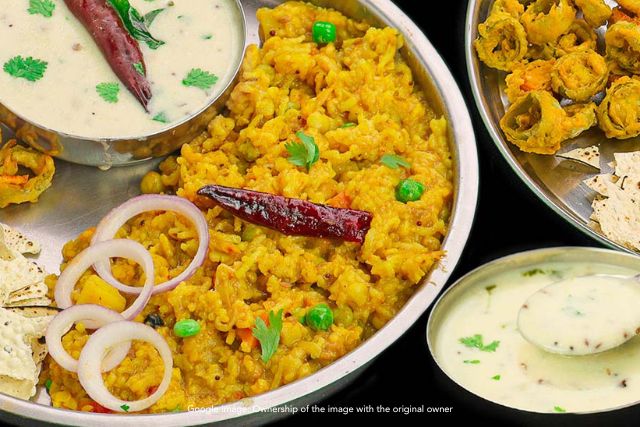
Thali Khechedi
A healthier version of Thali Khechedi using brown rice, split moong dal, less ghee, and jaggery instead of sugar.
Ingredients:
- 1 cup brown rice, soaked for 30 minutes and drained
- 1/2 cup split moong dal
- 1 tablespoon ghee
- 1/4 cup jaggery, grated
- 3 cups water
- 1/2 teaspoon turmeric powder
- A pinch of salt
Preparation: Heat ghee in a pot and add the soaked brown rice and moong dal. Sauté for a few minutes. Add water, turmeric powder, and salt. Bring to a boil, then reduce the heat and simmer for 40 minutes. Stir in the grated jaggery until it melts and blends well with the rice and lentils. Serve warm.
Health Facts About Split Moong Dal:
- High in protein and fiber.
- Low in fat and calories.
- Rich in essential vitamins and minerals.
Approximate Nutrient Breakdown Per 100 Grams:
- Calories: 120 kcal
- Carbohydrates: 22g
- Protein: 4g
- Fat: 1.5g
- Fiber: 2.5g
- Sodium: 5mg
- Potassium: 60mg
- Calcium: 15mg
- Iron: 1mg
- Vitamin C: 0mg
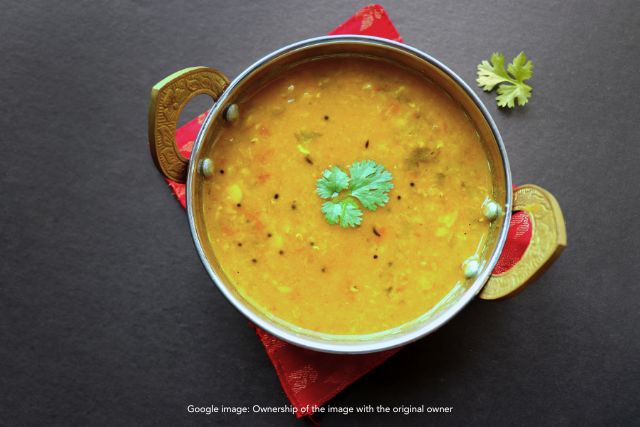
Toor Dal Bira Dali
Bira Dali is a beloved traditional dish, and our Healthy Bira Dali variant offers a nutritious twist on this classic recipe. By focusing on wholesome ingredients and minimizing added fats and sugars, this version ensures you can enjoy the dish while keeping health considerations in mind. The combination of split pigeon peas (toor dal) with aromatic spices creates a flavorful and satisfying meal that’s both rich in taste and beneficial for your well-being. Ideal for celebrations like Chappan Bhog during Janmashtami, this recipe maintains the spirit of the festival while adhering to health-conscious principles. The addition of fresh cilantro not only enhances the flavor but also adds a burst of freshness. Let’s dive into making this delectable and health-friendly Bira Dali!
OUR HEALTHY BIRI DALI RECIPE
Ingredients: 1 cup split pigeon peas (toor dal) 1 onion, finely chopped 1 tomato, chopped 1/2 teaspoon turmeric powder 1/2 teaspoon cumin seeds 1/2 teaspoon mustard seeds 1/2 teaspoon coriander powder 1/2 teaspoon chili powder Fresh cilantro for garnish Salt to taste 2 cups water
Preparation:
- Rinse 1 cup of split pigeon peas (toor dal) under cold water until the water runs clear.
- In a medium-sized pot, heat a small amount of oil or use a non-stick spray over medium heat.
- Add 1/2 teaspoon of mustard seeds and 1/2 teaspoon of cumin seeds to the pot and allow them to sizzle.
- Add 1 finely chopped onion to the pot and sauté until it becomes translucent.
- Stir in 1 chopped tomato and cook until it softens.
- Mix in 1/2 teaspoon of turmeric powder, 1/2 teaspoon of coriander powder, and 1/2 teaspoon of chili powder, cooking for a minute to let the spices release their flavors.
- Add the rinsed pigeon peas to the pot and stir to coat them with the spices and tomato mixture.
- Pour in 2 cups of water and bring the mixture to a boil.
- Reduce the heat to low, cover the pot, and let it simmer for about 20-25 minutes, or until the dal is tender and cooked through.
- Season with salt to taste and garnish with freshly chopped cilantro before serving.
Health Facts About Toor Dal:
- Rich in Protein: Split pigeon peas are an excellent source of plant-based protein, essential for muscle repair and overall body function.
- High in Fiber: This dish provides a significant amount of dietary fiber, which supports digestive health and helps maintain healthy cholesterol levels.
- Low in Fat: The recipe is low in added fats, making it a heart-healthy option.
- Supports Blood Sugar Control: The high fiber content helps regulate blood sugar levels, which is beneficial for those managing diabetes.
- Anti-inflammatory Properties: Turmeric and cumin seeds have anti-inflammatory effects that can help reduce inflammation in the body.
- Rich in Vitamins and Minerals: Ingredients like tomatoes and cilantro add essential vitamins (like vitamin C) and minerals (such as potassium) that contribute to overall health.
- Supports Weight Management: The high fiber and protein content can help you feel fuller for longer, aiding in weight management.
- Low in Sugar: There are no added sugars in this recipe, making it suitable for maintaining healthy blood sugar levels.
- Promotes Heart Health: The antioxidants and low-fat profile support cardiovascular health, reducing the risk of heart disease.
- Suitable for Special Occasions: This healthy version of Bira Dali aligns with the dietary needs during Chappan Bhog in Janmashtami, allowing for traditional celebration while adhering to health-conscious eating.
Approximate Nutrient Breakdown for 100 Grams of This Recipe: Calories: 140 kcal
Carbohydrates: 22g
Protein: 8g
Fat: 1g
Fiber: 6g
Sodium: 180mg
Potassium: 350mg
Calcium: 50mg
Iron: 3mg
Vitamin C: 8mg
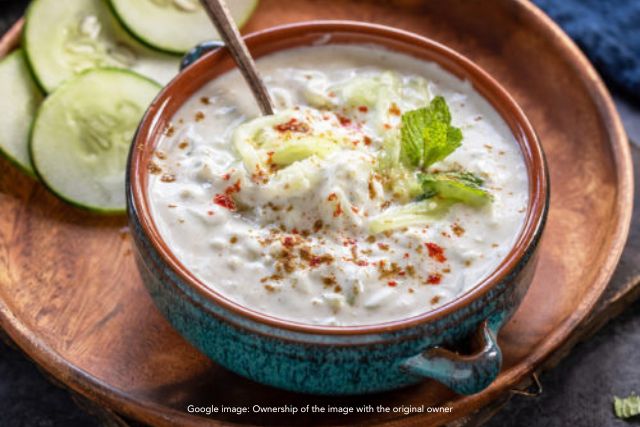
Veggie Raita
Elevate your festive gatherings with our Healthy Raita recipe, a refreshing yogurt-based side dish that is both nutritious and delicious. This lighter version uses low-fat curd and incorporates fresh radishes for an added crunch and flavor. Raita is known for its cooling properties, making it an ideal accompaniment for spicy Indian dishes. In this healthier variant, we maintain the traditional flavors while enhancing the nutrient profile. Perfect for celebrations like Janmashtami, this Raita not only complements your meals but also supports your health goals. Enjoy this guilt-free delight that adds a burst of freshness to your festive spread!
Ingredients:
1 cup low-fat curd
1/2 cup grated radish
1/4 cup chopped cucumber
1 tablespoon chopped mint leaves
1/4 teaspoon cumin powder
1/4 teaspoon black salt
1/4 teaspoon regular salt
1/4 teaspoon red chili powder (optional)
Preparation:
In a mixing bowl, add 1 cup of low-fat curd and whisk it until smooth and creamy.
- Grate 1/2 cup of fresh radish and add it to the bowl with the curd.
- Chop 1/4 cup of cucumber and add it to the mixture for added crunch and hydration.
- Incorporate 1 tablespoon of chopped mint leaves, which will enhance the freshness of the Raita.
- Sprinkle in 1/4 teaspoon of cumin powder to add some earthy flavor.
- Add 1/4 teaspoon of black salt for a unique taste and health benefits.
- Mix in 1/4 teaspoon of regular salt for seasoning; adjust according to your preference.
- If you prefer some heat, add 1/4 teaspoon of red chili powder to the mixture (optional).
- Gently stir all the ingredients together until well combined and the ingredients are evenly distributed.
- Refrigerate the Raita for at least 30 minutes before serving to allow the flavors to meld together and serve chilled.
Health Facts About Raita:
- Low-Calorie: Using low-fat curd significantly reduces calories while still providing a creamy texture.
- Hydration Boost: The addition of cucumber and radish helps keep the body hydrated, especially during festive celebrations.
- Digestive Aid: Yogurt is a probiotic that aids digestive health and improves gut flora.
- Rich in Vitamins: Radishes are packed with vitamins C and B6, which boost the immune system.
- Cooling Effect: Raita’s cooling properties help counterbalance spicy dishes often served during Janmashtami.
- Contains Minerals: Black salt is a source of essential minerals, promoting overall health.
- Heart-Healthy: Low-fat curd contains less saturated fat, making it heart-friendly.
- Enhances Flavor: The herbs and spices used in this Raita provide flavor without adding unhealthy ingredients.
- Weight Management: This dish can keep you full and satisfied while being low in calories, aiding in weight control.
- Perfect for Janmashtami: It complements traditional dishes served during Janmashtami, making meals more nutritious and enjoyable while celebrating the festival.
Approximate Nutrient Breakdown of This Recipe for 100 Grams:
Calories: 60 kcal
Carbohydrates: 8g
Protein: 3g
Fat: 2g
Fiber: 1g
Sodium: 300mg
Potassium: 200mg
Calcium: 150mg
Iron: 0.5mg
Vitamin C: 10mg
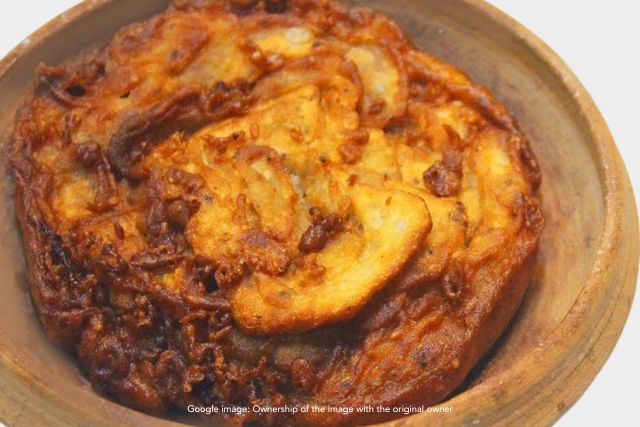
Whole Grain Tripuri
Discover a healthier version of the traditional Tripuri that doesn’t compromise on flavor while reducing fat content. By using whole grain flour and baking instead of frying, this recipe provides a nourishing alternative that supports a balanced diet. Tripuri, a delightful crisp snack, is often enjoyed during festive occasions like Janmashtami. This healthier variant makes it possible to indulge while still being mindful of your health. The combination of whole grain flour and olive oil adds essential nutrients and healthy fats, making this snack satisfying and wholesome. Perfect for your Chappan Bhog spread, this healthy Tripuri is sure to be a hit with everyone!
Ingredients: 1 cup whole grain flour, 2 tbsp olive oil, a pinch of salt
Preparation:
- Preheat your oven to 375°F (190°C) to prepare for baking the Tripuri.
- In a mixing bowl, add 1 cup of whole grain flour and a pinch of salt to taste.
- Pour in 2 tablespoons of olive oil and mix it into the flour until crumbly.
- Gradually add water, a little at a time, and knead the mixture until you form a soft dough.
- Cover the dough with a damp cloth and let it rest for about 15-20 minutes.
- Once rested, divide the dough into small balls for easy rolling.
- On a lightly floured surface, roll out each ball into thin circles, ensuring they are even.
- Place the rolled Tripuris on a baking sheet lined with parchment paper.
- Bake in the preheated oven for about 10-15 minutes, turning them halfway through, until they are golden brown and crisp.
- Allow the baked Tripuri to cool before serving them as a healthy snack or accompaniment to your meal.
Health Facts:
- Whole Grain Goodness: Whole grain flour is a rich source of fiber, promoting digestive health and helping maintain a healthy weight.
- Healthy Fats: Olive oil is rich in monounsaturated fats, which can help lower bad cholesterol levels and are beneficial for heart health.
- Low in Calories: Baking instead of frying significantly reduces the calorie content, making it a guilt-free snack option.
- Rich in Nutrients: Whole grains contain essential vitamins and minerals like iron, magnesium, and B vitamins that support overall well-being.
- Promotes Satiety: The fiber content in whole grain flour helps you feel full longer, reducing the likelihood of overeating.
- Supports Blood Sugar Control: Whole grains can help regulate blood sugar levels due to their slower digestion and absorption rates.
- Versatile Snack: Tripuri can be paired with various dips or yogurt, enhancing meal options without adding unhealthy ingredients.
- Ideal for Festivities: This healthier version of Tripuri fits perfectly into the Chappan Bhog during Janmashtami, allowing for festive indulgence without compromising health.
- Heart-Healthy Option: The combination of whole grains and olive oil supports cardiovascular health, an important consideration during festive meals.
- Easy to Prepare: This recipe is simple and straightforward, encouraging healthy cooking practices during celebrations while ensuring everyone can enjoy delicious treats.
Nutrient Breakdown per Serving: Calories: 90 kcal
Carbohydrates: 16g
Protein: 2g
Fat: 3g
Fiber: 2g
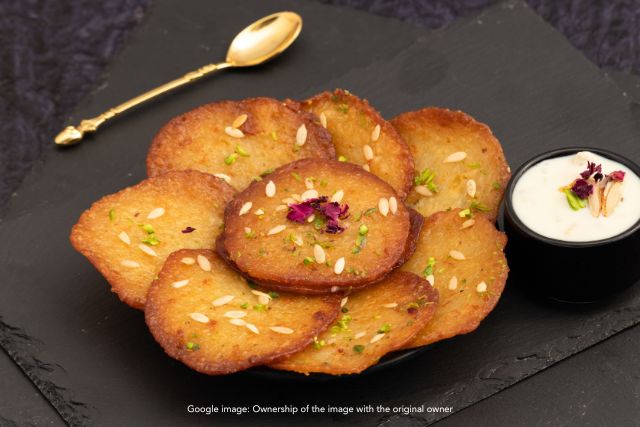
Whole Wheat Amalu
Get ready to indulge in a healthier twist on Amalu, a traditional dish that’s perfect for Janmashtami! This version substitutes refined sugar with naturally sweet dates, offering a nutritious alternative that enhances flavor and health benefits. By using whole wheat flour and coconut oil, we boost the dish’s fiber content and healthy fat profile. The result is a delightful treat that aligns with your wellness goals while preserving the essence of this beloved recipe. Perfect for festive occasions, this Amalu version provides a satisfying balance between taste and nutrition. Enjoy the festive season with a treat that’s both delicious and wholesome!
Ingredients:
- 1 cup whole wheat flour,
- 2 tbsp coconut oil,
- 1/4 cup dates (pitted and chopped),
- water as needed
Preparation:
- Preheat your oven to 350°F (175°C).
- In a large bowl, combine 1 cup of whole wheat flour with 2 tablespoons of coconut oil.
- Chop 1/4 cup of dates into small pieces and add them to the bowl.
- Mix the ingredients thoroughly until the dates are well distributed in the flour.
- Gradually add water, a little at a time, and knead the mixture into a dough.
- If the dough is too dry, add a small amount of water until it reaches a smooth consistency.
- Roll out the dough on a lightly floured surface to your desired thickness.
- Cut the dough into pieces or shapes of your choice.
- Place the pieces on a baking tray lined with parchment paper.
- Bake in the preheated oven for 15-20 minutes or until golden brown. Allow to cool before serving.
Health Facts:
- Whole Wheat Flour: Provides more fiber and essential nutrients compared to refined flour.
- Dates: Naturally sweeten the dish, offering vitamins, minerals, and antioxidants.
- Coconut Oil: Contains medium-chain triglycerides that are beneficial for metabolism.
- Low Glycemic Index: Dates have a lower glycemic index compared to refined sugar, helping to regulate blood sugar levels.
- Rich in Fiber: Whole wheat flour and dates contribute to digestive health and improve satiety.
- Healthy Fats: Coconut oil provides healthy fats that support heart health.
- Nutrient-Dense: Dates are rich in iron and potassium, which support overall health and energy levels.
- Natural Sweetness: Reduces the need for added sugars, lowering the calorie content.
- Sustained Energy: The combination of whole wheat flour and dates provides long-lasting energy.
- Reduced Processed Ingredients: Using whole food ingredients helps in minimizing intake of processed additives and unhealthy fats.
Nutrient Breakdown per Serving:
Calories: 95 kcal
Carbohydrates: 18g
Protein: 2g
Fat: 3g
Fiber: 2g
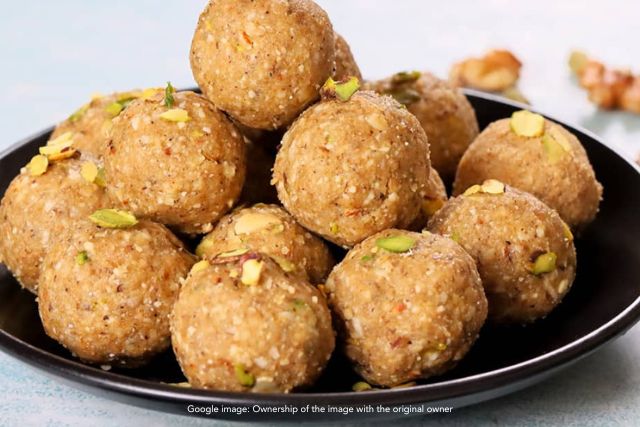
Whole Wheat Chadai Lada
Discover our healthy Chadai Lada recipe, a nourishing take on the traditional Janmashtami treat. We’ve replaced refined ingredients with whole wheat flour and coconut oil, and used dates as a natural sweetener to enhance the flavor and nutritional value. This wholesome version retains the rich taste of the classic ladoo while being kind to your health goals. Perfect for celebrating Janmashtami, these ladoos offer a delightful balance of taste and nutrition. They provide essential nutrients without compromising on the festive spirit. Enjoy a treat that aligns with your health-conscious lifestyle while honoring tradition!
Ingredients:
- 1 cup whole wheat flour
- 2 tablespoons coconut oil
- 1/2 cup dates, pitted and chopped
- 1/4 cup nuts (almonds, cashews), chopped
- 1/2 teaspoon cardamom powder
PREPARATION:
- Heat the coconut oil in a non-stick pan over medium heat.
- Add the whole wheat flour to the pan and roast, stirring continuously, until it turns golden brown and aromatic.
- Add the chopped dates to the pan and continue to cook for a few minutes until the dates soften.
- Stir in the chopped nuts and cardamom powder, mixing well to combine with the flour and dates.
- Cook the mixture for another 2-3 minutes, ensuring everything is well incorporated.
- Remove the pan from heat and let the mixture cool slightly.
- Once cool enough to handle, shape the mixture into small balls or ladoos using your hands.
- Place the ladoos on a plate or tray and allow them to cool completely and firm up.
- Store the ladoos in an airtight container at room temperature for up to a week.
- Enjoy your healthy Chadai Lada as a festive treat or a nutritious snack!
HEALTH FACTS ABOUT COCONUT OIL AND DATES:
- Whole Wheat Flour: Provides more fiber and nutrients compared to refined flour, aiding in digestive health.
- Coconut Oil: Contains healthy fats and medium-chain triglycerides (MCTs) that can support energy and metabolism.
- Dates: A natural sweetener that provides essential minerals like potassium and magnesium, and is high in fiber.
- Nuts: Offer healthy fats, protein, and a range of vitamins and minerals, contributing to heart health and satiety.
- Cardamom: Adds flavor and has potential digestive benefits, including anti-inflammatory properties.
- Lower in Refined Sugar: Natural sweeteners reduce the glycemic impact, supporting better blood sugar control.
- Rich in Antioxidants: Ingredients like nuts and dates provide antioxidants that help protect against oxidative stress.
- Improves Satiety: The combination of fiber from whole wheat flour and dates helps keep you full longer.
- Supports Heart Health: Healthy fats from coconut oil and nuts promote heart health and reduce cholesterol levels.
- Nutrient-Dense: Provides essential nutrients without the excess calories or unhealthy fats commonly found in traditional sweets.
APPROXIMATE NUTRIENT BREAKDOWN (per 100g):
Calories: 210 kcal
Carbohydrates: 38g
Protein: 4g
Fat: 7g
Fiber: 5g
Sodium: 5mg
Potassium: 200mg
Calcium: 30mg
Iron: 1.8mg
Vitamin C: 0mg
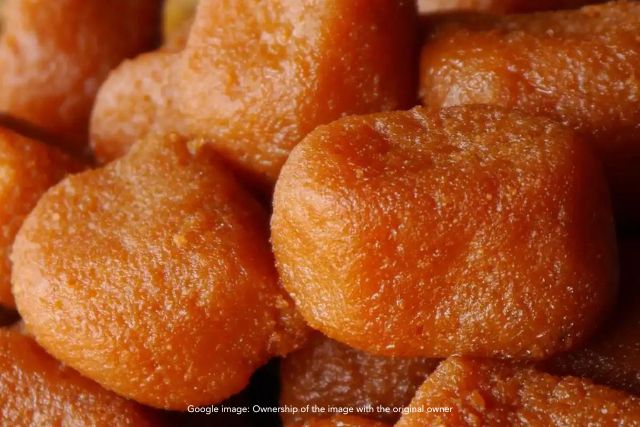
Whole Wheat Gaja
Make a healthier Gaja by using whole wheat flour, coconut oil instead of ghee, and natural sweeteners, ensuring a nutritious treat for your festivities.
Ingredients: 1 cup whole wheat flour 2 tablespoons coconut oil 1/4 cup jaggery syrup A pinch of cardamom powder A pinch of salt Water as needed
Preparation: Combine the whole wheat flour, coconut oil, jaggery syrup, cardamom powder, and salt. Add water as needed to form a dough. Roll out the dough and cut into small pieces. Bake at 180°C (350°F) for 15-20 minutes until golden brown.
Health Facts:
- Whole wheat flour is high in fiber and nutrients.
- Coconut oil offers healthy fats.
- Jaggery is a healthier alternative to refined sugar.
Nutrient Breakdown (per 100 grams): Calories: 135 kcal
Carbohydrates: 26g
Protein: 3g
Fat: 3.5g
Fiber: 3g
Sodium: 10mg
Potassium: 50mg
Calcium: 15mg
Iron: 1mg
Vitamin C: 0mg
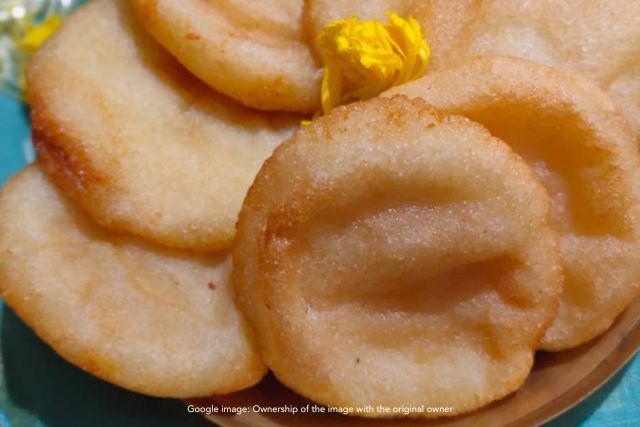
Whole Wheat Kakara
Kakara is a traditional Indian snack that is often enjoyed during festive occasions, particularly during Janmashtami. This healthier version of Kakara replaces refined flour with whole wheat flour and reduces the use of ghee, making it a more nutritious choice. By using jaggery powder instead of sugar, the recipe gains additional health benefits, including improved digestion and increased iron content. Cardamom powder adds a delightful flavor and offers digestive benefits as well. This variant retains the essence of the original Kakara while aligning with modern health-conscious practices. Enjoy this guilt-free treat as a part of your Janmashtami celebrations or any time you desire a wholesome snack.
Ingredients: 1 cup whole wheat flour 1/2 cup jaggery powder 2 tablespoons ghee 1/4 teaspoon cardamom powder
Preparation:
- Preheat a pan on low heat.
- Add the ghee to the pan and let it melt completely.
- In a mixing bowl, combine the whole wheat flour and jaggery powder.
- Gradually add the melted ghee to the flour mixture, mixing thoroughly to incorporate.
- Add cardamom powder to the mixture and stir well.
- Knead the dough gently, adding a small amount of water if necessary to achieve a smooth consistency.
- Divide the dough into small balls and flatten each ball into a small, round disc.
- Heat a griddle or non-stick pan on medium heat.
- Cook each disc on the griddle, pressing gently with a spatula, until golden brown on both sides.
- Remove from the pan and let cool before serving.
Health Facts:
- Whole Wheat Flour: Rich in fiber, whole wheat flour supports digestive health and helps in maintaining a healthy weight.
- Jaggery Powder: Provides essential minerals such as iron, which helps in preventing anemia and improving blood circulation.
- Ghee: When used in moderation, ghee is a good source of healthy fats that aid in digestion and boost immunity.
- Cardamom Powder: Known for its anti-inflammatory and digestive benefits, cardamom helps in reducing bloating and indigestion.
- Low Glycemic Index: The combination of whole wheat flour and jaggery has a lower glycemic index compared to refined flour and sugar, making it a better choice for managing blood sugar levels.
- Nutrient-Rich: Whole wheat flour is rich in B vitamins, which are crucial for energy production and overall health.
- Antioxidants: Jaggery contains antioxidants that help in fighting oxidative stress and protecting the body from diseases.
- Weight Management: The fiber content in whole wheat flour promotes satiety and can assist in weight management.
- Better Digestion: Ghee and cardamom both contribute to improved digestive health and can help in alleviating digestive issues.
- Festive Nutrition: During Janmashtami, this healthier version of Kakara offers a traditional taste with added nutritional benefits, making it a thoughtful choice for celebrations.
Approximate Nutrient Breakdown (per 100 grams): Calories: 230 kcal Carbohydrates: 40g Protein: 3g Fat: 8g Fiber: 4g Sodium: 5mg Potassium: 90mg Calcium: 20mg Iron: 2mg
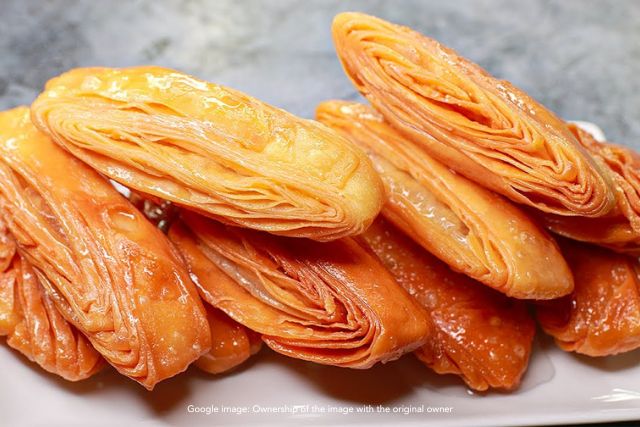
Whole Wheat Khaja
Enjoy a healthier variant of Khaja by using whole wheat flour and baking instead of frying, creating a delicious and nutritious snack for your celebrations.
Ingredients: 1 cup whole wheat flour 2 tablespoons coconut oil 1/4 cup jaggery syrup A pinch of cardamom powder A pinch of salt Water as needed
Preparation: Mix the whole wheat flour, coconut oil, jaggery syrup, cardamom powder, and salt. Add water as needed to form a dough. Roll out the dough and cut into desired shapes. Bake at 180°C (350°F) for 15-20 minutes until golden brown.
Health Facts:
- Whole wheat flour is rich in fiber and nutrients.
- Baking reduces the fat content compared to frying.
- Jaggery provides a natural sweetness with added minerals.
Nutrient Breakdown (per 100 grams): Calories: 130 kcal
Carbohydrates: 25g
Protein: 3g
Fat: 3g
Fiber: 3g
Sodium: 10mg
Potassium: 50mg
Calcium: 15mg
Iron: 1mg
Vitamin C: 0mg
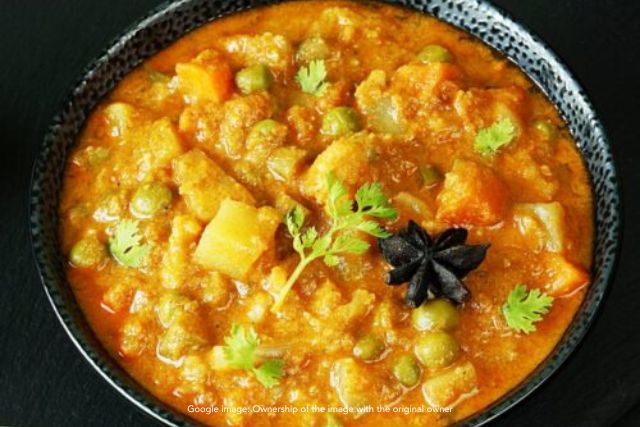
Whole Wheat Khuruma
Indulge in a healthier version of Khuruma – a crunchy and delightful snack made with wholesome ingredients, ensuring a tasty and nutritious treat perfect for festive celebrations.
Ingredients: 1 cup whole wheat flour 1/4 cup jaggery powder 2 tablespoons coconut oil 1/4 teaspoon salt
Preparation: Combine whole wheat flour, jaggery powder, coconut oil, and salt in a bowl. Knead into a dough and roll it out into small shapes. Bake at 180°C for 15-20 minutes or until golden brown.
Health Facts: Whole wheat flour is high in fiber. Coconut oil provides healthy fats. Jaggery is a natural sweetener rich in minerals.
Approximate Nutrient Breakdown (per 100 grams): Calories: 220 kcal Carbohydrates: 35g Protein: 3g Fat: 9g Fiber: 3g Sodium: 70mg Potassium: 80mg Calcium: 20mg Iron: 1.5mg
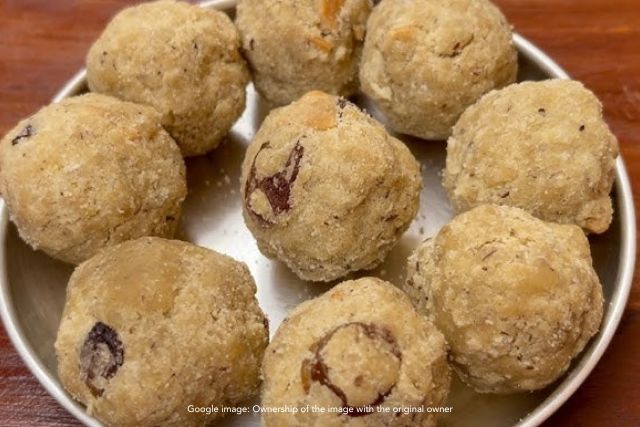
Whole wheat Laddu
Create a healthier Laddu by using whole wheat flour, jaggery, and coconut oil, providing a delicious and nutritious sweet treat for your festive celebrations.
Ingredients: 1 cup whole wheat flour 1/4 cup jaggery, grated 2 tablespoons coconut oil A pinch of cardamom powder A handful of chopped nuts (optional)
Preparation: Toast the whole wheat flour in a pan until aromatic. Add the grated jaggery and coconut oil, mixing well. Add cardamom powder and chopped nuts if desired. Shape the mixture into small balls and let them cool.
Health Facts:
- Whole wheat flour is high in fiber and nutrients.
- Jaggery offers a natural sweetness with minerals.
- Coconut oil contains healthy fats.
Nutrient Breakdown (per 100 grams): Calories: 140 kcal
Carbohydrates: 28g
Protein: 3g
Fat: 3.5g
Fiber: 3g
Sodium: 10mg
Potassium: 50mg
Calcium: 15mg
Iron: 1mg
Vitamin C: 0mg
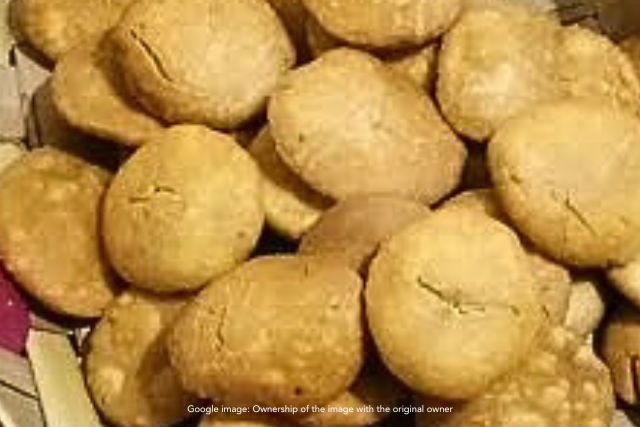
Whole Wheat Luni Khuruma
Luni Khuruma is a delightful and wholesome treat that brings a healthier twist to a traditional favorite. Ideal for festive occasions like Janmashtami, this recipe combines the rich flavors of jaggery and ghee with the nutritional benefits of whole wheat flour. Unlike many indulgent snacks, Luni Khuruma is prepared with minimal ghee, making it a lighter option without compromising on taste. This recipe is perfect for those looking to enjoy a festive treat while maintaining a balanced diet. By using jaggery, a natural sweetener, this recipe also adds a depth of flavor and additional health benefits. Savor the goodness of this nutritious snack that’s both delicious and good for you.
Ingredients: 1 cup whole wheat flour 1/4 cup jaggery powder 2 tablespoons ghee 1/4 teaspoon salt
Preparation:
- Gather Ingredients: Assemble 1 cup whole wheat flour, 1/4 cup jaggery powder, 2 tablespoons ghee, and 1/4 teaspoon salt.
- Melt Ghee: In a small pan, gently melt the ghee over low heat until it becomes liquid.
- Mix Dry Ingredients: In a large mixing bowl, combine the whole wheat flour, jaggery powder, and salt.
- Combine Ingredients: Pour the melted ghee into the dry mixture and mix well until the ingredients are thoroughly combined.
- Knead Dough: Gradually add a small amount of water if needed to form a soft, pliable dough.
- Shape Dough: Take small portions of the dough and roll them into small balls or desired shapes.
- Prepare for Cooking: Flatten each ball slightly using your palm or a rolling pin.
- Cook the Khuruma: Heat a non-stick pan over medium heat. Place the flattened dough onto the pan and cook until golden brown on both sides, pressing gently with a spatula.
- Cool Down: Allow the Khuruma to cool on a wire rack or a plate.
- Serve: Enjoy the Luni Khuruma as a tasty and healthy snack, perfect for festive celebrations.
Health Facts:
- Whole Wheat Flour: Rich in fiber, whole wheat flour supports digestive health and helps maintain steady blood sugar levels.
- Jaggery: Provides essential minerals like iron, magnesium, and potassium, which can help improve blood circulation and overall energy levels.
- Minimal Ghee: Using less ghee reduces the overall fat content, making the recipe lighter and heart-healthy.
- Low Glycemic Index: The combination of whole wheat flour and jaggery results in a lower glycemic index compared to refined flour snacks, benefiting blood sugar management.
- Antioxidants: Jaggery contains antioxidants that help fight oxidative stress and inflammation in the body.
- Vitamins and Minerals: Whole wheat flour is a good source of B vitamins, iron, and magnesium, contributing to overall health and well-being.
- Digestive Benefits: The fiber content in whole wheat flour aids in digestion and helps prevent constipation.
- Energy Boost: Jaggery provides a quick source of natural energy, making it a better alternative to refined sugars.
- Balanced Nutrition: This recipe avoids refined ingredients and excessive fats, making it a healthier option for festive snacking.
- Festive Fit: Luni Khuruma is a nutritious choice for Janmashtami, allowing you to enjoy traditional flavors while staying mindful of health.
Approximate Nutrient Breakdown (per 100 grams): Calories: 220 kcal Carbohydrates: 35g Protein: 3g Fat: 9g Fiber: 3g Sodium: 70mg Potassium: 80mg Calcium: 20mg Iron: 1.5mg
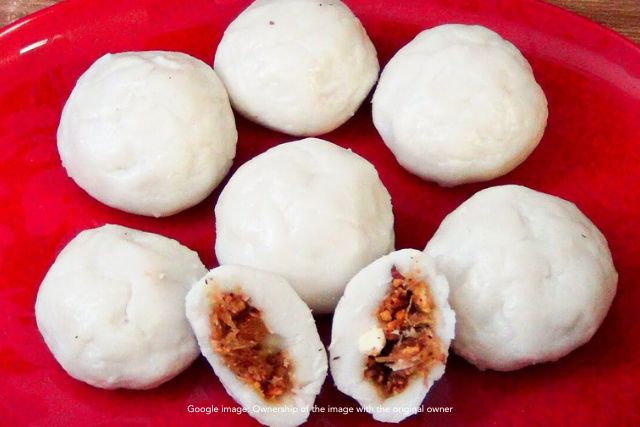
Whole Wheat Manda
Manda, a traditional sweet treat, often finds its way into celebrations and special occasions. To give this cherished recipe a healthier twist, we can use whole wheat flour and coconut oil instead of refined wheat flour and ghee. This variation not only reduces the fat content but also adds a touch of natural sweetness with jaggery. Whole wheat flour provides more fiber and essential nutrients compared to its refined counterpart, making the recipe more wholesome. Coconut oil is known for its beneficial fats, which support overall health. By incorporating jaggery, this version of Manda offers a healthier alternative to processed sugars.
Ingredients: 1 cup whole wheat flour, 2 tbsp coconut oil, 1 tbsp jaggery, water as needed
Preparation
- Combine Dry Ingredients: In a mixing bowl, add 1 cup of whole wheat flour.
- Add Jaggery: Crush 1 tablespoon of jaggery into the flour and mix thoroughly.
- Heat Coconut Oil: In a small pan, gently heat 2 tablespoons of coconut oil until melted.
- Mix Wet and Dry Ingredients: Pour the melted coconut oil into the flour and jaggery mixture.
- Form a Dough: Gradually add water as needed and knead the mixture into a smooth dough.
- Rest the Dough: Cover the dough and let it rest for about 15 minutes.
- Prepare for Cooking: Divide the dough into small, equal-sized balls.
- Flatten the Balls: Using a rolling pin, flatten each ball into a round, thin disc.
- Cook the Discs: Heat a non-stick pan over medium heat and cook each disc until golden brown on both sides.
- Cool and Serve: Allow the Mandas to cool before serving.
Health Facts:
- Whole Wheat Flour Benefits: Whole wheat flour is richer in fiber and nutrients compared to refined flour, aiding in digestion and overall health.
- Coconut Oil Advantages: Coconut oil contains medium-chain triglycerides (MCTs), which are known for their energy-boosting properties and potential metabolic benefits.
- Jaggery's Natural Sweetness: Jaggery is a natural sweetener that provides essential minerals like iron and magnesium, which support various bodily functions.
- Lowered Fat Content: By substituting ghee with coconut oil, the overall fat content is reduced, making the recipe lighter and healthier.
- Enhanced Nutritional Profile: This healthier version of Manda retains the traditional flavors while offering a more balanced nutritional profile.
- Supports Digestion: Whole wheat flour contains bran and germ, which are beneficial for digestive health.
- Improves Energy Levels: The combination of whole wheat flour and jaggery provides sustained energy, ideal for maintaining stamina during festivities.
- Antioxidant Properties: Coconut oil has antioxidant properties that help combat oxidative stress and inflammation in the body.
- Traditional Celebrations: This healthier Manda variant is a suitable option for Chappan Bhog during Janmashtami, aligning with dietary preferences that prioritize well-being.
- Cultural Relevance: By making this adjustment, the recipe honors traditional flavors while accommodating modern health-conscious practices.
Nutrient Breakdown per Serving: Calories: 90 kcal
Carbohydrates: 15g
Protein: 2g
Fat: 3g
Fiber: 2g
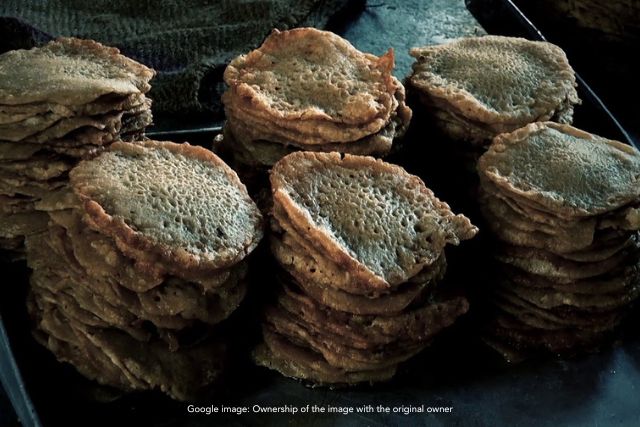
Whole Wheat Rosapaik
Rosapaik is a delightful dish often enjoyed during special occasions, and this healthy variant is perfect for those seeking a nutritious twist. By using whole wheat flour and a natural sweetener like honey, you can indulge in this treat while keeping health in mind. Whole wheat flour adds a rich source of fiber and essential nutrients, while honey offers a more wholesome sweetness compared to refined sugars. The inclusion of coconut oil provides healthy fats that are beneficial for your body. This recipe maintains the essence of traditional Rosapaik while aligning with a healthier lifestyle. Perfect for festive occasions like Janmashtami, it’s a delicious way to celebrate without compromising on nutrition.
Ingredients: 1 cup whole wheat flour, 2 tbsp honey, 1 tbsp coconut oil
Preparation:
- Mix the Dry Ingredients: In a large bowl, combine 1 cup of whole wheat flour with a pinch of salt if desired.
- Add the Sweetener: Pour in 2 tablespoons of honey, mixing it thoroughly into the flour.
- Incorporate Coconut Oil: Melt 1 tablespoon of coconut oil and add it to the mixture.
- Combine Ingredients: Use your hands or a spoon to mix the ingredients until they form a crumbly texture.
- Add Water Gradually: Slowly add water, a little at a time, until the dough comes together and is smooth.
- Knead the Dough: Knead the dough for a few minutes until it becomes soft and pliable.
- Rest the Dough: Cover the dough with a damp cloth and let it rest for about 15 minutes.
- Shape the Dough: Divide the dough into small balls and flatten them into thin discs.
- Cook the Discs: Heat a non-stick pan over medium heat and cook each disc until golden brown on both sides.
- Serve: Allow the Rosapaik to cool slightly before serving. Enjoy your healthy treat!
Health Facts:
- Whole Wheat Flour: Rich in dietary fiber, whole wheat flour aids digestion and helps maintain a healthy weight.
- Natural Sweetener: Honey provides natural antioxidants and can help reduce the risk of heart disease.
- Coconut Oil: Contains medium-chain triglycerides (MCTs) that are easily metabolized and support brain health.
- Reduced Sugar Intake: Using honey instead of refined sugar lowers the glycemic index, which helps regulate blood sugar levels.
- Heart Health: Whole wheat flour and honey together can contribute to a heart-healthy diet by providing essential nutrients.
- Improved Metabolism: The healthy fats in coconut oil can help boost metabolism and increase energy levels.
- Traditional Health Benefits: Rosapaik, traditionally consumed during Janmashtami, can be a healthier option with these substitutions.
- Antioxidant Boost: Honey has natural antioxidants that can help combat oxidative stress and inflammation.
- Digestive Health: Whole wheat flour supports digestive health due to its high fiber content.
- Reduced Caloric Intake: This variant of Rosapaik has fewer calories compared to versions made with refined flour and sugar, making it a better choice for maintaining a balanced diet.
Nutrient Breakdown per Serving: Calories: 95 kcal
Carbohydrates: 18g
Protein: 2g
Fat: 3g
Fiber: 2g








